Trends in Atmospheric Emissions in Central Asian Countries Since 1990 in the Context of Regional Development
Abstract
1. Introduction
- Compares CO2, PM2.5 and SO2 emissions in CACs;
- Assesses the impact of economic structure on pollution levels;
- Examines current strategies for reducing emissions and provides recommendations for adapting them to regional conditions.
2. Materials and Methods
2.1. Research Methodology
- The heterogeneity of data across countries in the region, which requires a comprehensive approach to their analysis; the dynamic nature of emissions, which must be assessed over time (1990–2024);
- The relationship between economic structure and pollution levels, which requires the use of econometric indicators;
- International commitments of CACs to reduce emissions, which makes a comparative analysis of strategies and policies necessary.
- Scientometric analysis of publications. It will be the study of publications devoted to the problem of air pollution.
- Identification of the Central Asia economy sectors features. It will identify the answer to the question: What economic sectors and factors have the most significant impact on air quality? To assess the relationship between the economic structure of countries and the level of pollution, methods of descriptive statistics, correlation analysis and regression modeling are used. Then it is necessary to estimate problems and challenges. To evaluate the energy efficiency of the CACs economies, indicators such as the following:
- Energy Intensity of CACs for the period 1990–2022;
- Specific CO2 Emissions per capita;
- Specific CO2 Emissions per GDP;
- GDP per unit of energy consumption, quoted in dollars per kilogram of oil equivalent were used.
- Assessment of the ecological-climatic changes impact on air quality of the region. To study the pollution dynamics, a statistical analysis of time series (1990–2024) of CO2, PM2.5 and SO2 emissions is carried out. To achieve this goal, indicators, such as the following, were used:
- The volume of GHGs in CACs for the period 1990–2021;
- Average CO2 emission (carbon factor) during 1990–2023;
- Dynamics of CO2 emissions by burning fossil fuels of CACs for the period 1990–2022;
- Dynamics of PM2.5, SO2 in CACs for the period 1990–2024.
- Econometric modeling in the R program was used to identify relationships between CO2 emissions from fuel combustion and the factors that determine it, taking into account the specifics of country development:
- Dependent and independent variables were identified for all five countries;
- A correlation analysis of the dependence of the indicators was carried out, a thermal matrix was constructed;
- A fixed effects (FE) model and a random effects (RE) model were constructed;
- For comparison of fixed effects and random effects models, We used both approaches to estimate the fixed effects model—the classical Wallace–Hussain method, as well as the more robust Amemiya method, recommended for analyzing small panel samples (n = 5 countries);
- A forecast of indicators based on the constructed model for all five countries to identify the achievability of the climate parameters declared by the countries by 2030 was built.
- Strategies in Central Asia for implementing measures to reduce air pollution. Development of Recommendations for improvement. To provide a comparative analysis of emission reduction strategies, the environmental strategies of the CACs are examined in comparison with successful cases from other regions, including EU policies (ETS, European Green Deal), the Chinese air pollution strategy and the US experience in emission regulation.
2.2. Data Sources
- Scientometric analysis of publications from Scopus and WebScience databases was carried out using VoSViewer: by keywords, by country, by author [27].
- Identification of the Central Asia economy sectors features was carried out using environmental indicators, economic and energy indicators that make it possible to understand the relationship between economic activity and the level of atmospheric pollution [17,23,28,29,30,31,32,33,34]. Data regarding energy, fuel consumption and air emissions are gathered and systematized by national statistical offices, energy departments and environmental protection agencies. The work used information from the National Statistics Bureau of the CACs; however, it should be noted that they are systematized mainly in Kazakhstan and Kyrgyzstan. Thus, only in Kazakhstan and Kyrgyzstan are the National Ambient Air Quality Standards (NAAQS) enshrined in laws available for review [29,35]. The following are used as key indicators:
- Assessment of the ecological-climatic changes impact on air quality of the region: It was used the National Communications and the Biennial Reports of the CACs to the UNFCCC [36,37,38,39,40]. The use of GHG inventory data in the analysis of atmospheric emissions in Central Asia is justified, because they are based on international standardized methodologies Intergovernmental Panel on Climate Change (IPCC) Guidelines 2006, mainly Tier 1, (Tier 2 Method: for waste, agriculture sectors), which allows for the comparison of analogous data, the assessment of emissions and their sources [41]. CH4 emissions mainly occur in agricultural production were obtained from GHG inventory data, supplemented by data from the Bureau of National Statistics and TheGlobalEconomy.com [28,35,42]. The lack of data on other pollutants from industry, transport, and energy that are not related to GHGs, such as PM2.5, was filled in from relevant sources [29,30,31,32,33,34].
- The ratio of specific CO2 emissions from fuel combustion to GDP is expressed in kilograms of CO2 per unit of GDP and serves as a significant measure for assessing the carbon intensity of an economy. The data are presented at UNECE, Data Portal https://w3.unece.org/SDG/ru/Indicator?id=28 (accessed 10 October 2024). [38].
- Strategies in Central Asia for implementing measures to reduce air pollution. Development of Recommendations for improvement.
3. Results
3.1. Scientometric Analysis of Publications
3.2. Identification of the Central Asia Economy Sectors Features
3.2.1. A Comparative Assessment of Key Fuel and Energy Resources
- -
- Population growth (in 2023, the population growth rate in the region ranged from 1.3% to 2.1%, compared to the global average of 0.9%);
- -
- Rising urbanization (urbanization rates in the region ranged from 38% to 58% in 2023, compared to the global average of 57%);
- -
- An increase in housing construction (for example, between 1990 and 2019, Kyrgyzstan’s housing stock increased by 30 million m2);
- -
- Infrastructure development (in 2023, the share of services in Kazakhstan’s GDP reached 55.97%, aligning closely with the global average of 54.52%) [34].
- The historically established energy-intensive structure of the industrial economy with low added value;
- The overall technological backwardness of production processes;
- The severe continental climate, characterized by prolonged and harsh winters;
- The vast territory and extensive transport infrastructure, including oil and gas pipelines, electricity transmission lines and water supply systems.
3.2.2. The Relationship Between the Economic Structure of Countries and the Level of Pollution
3.3. Assessment of the Impact of Ecological-Climatic Changes on the Regional Air Quality
3.3.1. Comparative Analysis of National GHG Emission Reduction Strategies
3.3.2. Study of the Dynamics of Fossil CO2, PM2.5 and SO2 Emissions in Central Asian Countries
3.4. Econometric Modeling in the R Program
| Variables | |||
| y1 | CO2 emissions from fuel combustion, Mt | x6 | GDP, billion USD |
| x1 | coal consumption, Mt | x7 | Energy consumption, Mtoe |
| x2 | Oil product consumption, Mt | x8 | SO2 emissons, kt |
| x3 | natural gas consumption, Mt | x9 | PM2.5 emission, kt |
| x4 | global carbon factor, tCO2/toe | x10 | share of RES, % |
| x5 | energy intensity, koe/$15p | x11 | CO2 emissions per capita, t/person |
- -
- it accounts for potential correlation between individual effects and explanatory variables;
- -
- it provides better interpretability with a small number of panel units.
| Estimate | Std. Error | t value | Pr(>|t|) |
| x3—9.8700997 | 4.8508973 | 2.0347 | 0.04699 * |
| x4—0.1133392 | 0.0075953 | 14.9223 | <2.2 × 10−16 *** |
| x5—2.4902838 | 0.3897199 | 6.3899 | 4.64 × 10−8 *** |
3.5. CO2 Emissions Forecast for 2024–2030 by Country
| Year | Energy Consumption | GDP | Coal Consumption | Carbon Intensity | Calculation of Projected CO2 Emissions |
|---|---|---|---|---|---|
| Units | Mtoe | Billion USD | Mt | tCO2/toe | Mt |
| 2024 | 88.0 × 1.015 = 89.32 | 262.4 × 1.03 = 270.272 | 74.0 × 0.99 = 73.267 | 3.23 × 0.995 = 3.214 | 284.48 |
| 2025 | 89.32 × 1.012 = 90.392 | 270.272 × 1.032 = 278.921 | 73.26 × 0.985 = 72.177 | 3.214 × 0.99 = 3.182 | 289.57 |
| 2026 | 90.392 × 1.01 = 91.296 | 278.921 × 1.035 = 288.683 | 72.17 × 0.98 = 70.737 | 3.182 × 0.988 = 3.144 | 290.84 |
| 2027 | 91.30 × 1.008 = 92.03 | 288.68 × 1.033 = 298.23 | 70.73 × 0.975 = 68.94 | 3.144 × 0.985 = 3.097 | 293.71 |
| 2028 | 92.03 × 1.007 = 92.68 | 298.23 × 1.031 = 307.48 | 68.94 × 0.97 = 66.87 | 3.097 × 0.982 = 3.048 | 295.42 |
| 2029 | 92.68 × 1.005 = 93.14 | 307.48 × 1.030 = 316.70 | 66.87 × 0.965 = 64.50 | 3.048 × 0.980 = 2.987 | 298.97 |
| 2030 | 93.14 × 1.003 = 93.42 | 316.70 × 1.028 = 325.59 | 64.50 × 0.96 = 61.92 | 2.987 × 0.975 = 2.913 | 298.59 |
| Metrics | Value (Training Set) | Metrics | Value (Training Set) |
| RMSE | 2.007888 | MAPE | 1.475433 |
| MAE | 1.505546 | MASE | 0.3943097 |
| MPE | −0.03831139 | ACF1 | −0.05035955 |
3.6. Strategies in Central Asia for Implementing Measures to Reduce Air Pollution
| Factors/Conditions | Expected Results | Risks | Sustainable Development Goals: Indicators |
|---|---|---|---|
| Population and economic growth | Increase atmospheric emissions and place excessive pressure on key natural resources and ecosystems | Drying up of the Aral Sea, water shortages, droughts, extreme heat, unstable precipitation patterns, dust storms | SDG3: Good Health and Well Being; SDG2: Zero Hunger; SDG 8: Decent Work and Economic Growth; SDG10: Reduced Inequality; SDG 11: Sustainable Cities and Communities SDG 13: Climate Action |
| Decarbonization of the economy | National low-carbon development strategies, strengthening regional cooperation mechanisms to identify measures for adaptation to climate change, priorities for the most effective allocation of investments, development of a joint environmental protection program for sustainable development in Central Asia. | Financial burden on the budget of countries; social risks associated with job losses, difficulties in adaptation and implementation of new technologies | SDG 7: Affordable and Clean Energy; SDG5: Gender Equality; SDG 8: Decent Work and Economic Growth; SDG9: Industry, Innovation and Infrastructure; SDG11: Sustainable Cities and Communities; SDG12: Responsible Consumption and Production; SDG 13: Climate Change Adaptation. |
| Formation of a green strategy | Investments in low-carbon technologies, replacement of coal with gas fuel at thermal power plants, “green” projects, including RES, energy-efficient and resource-efficient technologies, modernization of the water and energy complex, land reclamation projects, combating desertification and reforestation, creating a modern transport and logistics system, “transition” to sustainable transport, efficient waste management | Significant investment in sustainable technologies and infrastructure will be required; social, technological and political risks | SDG 7: Affordable and Clean Energy; SDG 8: Decent Work and Economic Growth; SDG 11: Sustainable Cities and Communities; SDG12: Responsible Consumption and Production; SDG 13: Climate Change SDG 15: Life on Land |
| Implementation of international air quality standards, control systems and the best available technologies | Use of NetZero, water and waste management, Air Quality Control System, implementation of Air Quality Standards, energy strategy for Sustainability | Rising energy costs | SDG 3: Good Health and Well Being; SDG 9: Industry, Innovation and Infrastructure; SDG11: Sustainable Cityes and Communities; SDG12: Responsible Consumption and Production; |
| Environmental Aspects Registers (EnvAR) electronic registers of environmental aspects | Documentation and Analysis; Automatic tracking: waste, emissions, spills, energy consumption; Documentation and Analysis; Regulatory Compliance, Support for Environmental Management System; Transparency and Accountability | Additional costs | SDG3: Good Health and Well Being; SDG 8: Decent Work and Economic Growth; SDG11: Sustainable Cities and Communities; SDG12: Responsible Consumption and Production; SDG 13: Climate Change |
- 1.
- Introducing United data metric
- Data standardization: development of common standards for collecting and analyzing air quality data, which will ensure comparability of data between countries. First of all, countries in the region need to move from declarative environmental regulation to strict, scientifically based standards governing emissions of CO2, PM2.5, SO2 and other pollutants.
- Improved monitoring: the introduction of modern technologies for monitoring pollutants, which will allow for more accurate assessment of pollution levels and the adoption of measures to prevent them. This requires the creation of independent emission control agencies, the introduction of a mandatory air quality monitoring system based on modern technologies, including remote measurements and automated databases.
- The introduction of a digital reporting system and the integration of emission data into national and regional platforms will increase the transparency of environmental regulation and reduce corruption risks.
- 2.
- Changing the structure of national economies
- Investment in RES: increasing the share of RES: hydropower, solar and wind energy, which will help reduce dependence on fossil fuels and reduce carbon emissions. Countries can work with international financial institutions, such as the World Bank and the Asian Development Bank, to obtain funding for RES projects. These organizations can offer both financial support and technical assistance. Also, China’s involvement in solar and wind energy development could be an important factor in increasing the share of RES in the region. Kazakhstan and Uzbekistan have set goals to significantly increase the share of RES [24,25,39]. Other CACs may also develop national strategies to increase the share of RES.
- Adopting of Best Available Technologies: stimulating the transition to technologies that require less energy to produce and operate.
- It is necessary to modernize the existing coal infrastructure by introducing carbon capture, utilization and storage (CCUS) technologies.
- Development of legislative initiatives: adoption of laws and regulations aimed at supporting clean technologies and reducing air pollution from stationary emission sources. For example, it is necessary to create and implement legislation that supports the use of RES, including tax incentives for investors, subsidies for solar and wind installations, and guarantees for the purchase of electricity from RES.
- 3.
- Strengthening regional and international cooperation
- Mitigation of the effects of climate change and adaptation to it. Key aspects include the development of highly accurate models for predicting climate risks and assessing the impact of emissions on the environment and public health.
- Combating desertification.
- Environmental protection in general and, in particular, protection of atmospheric air.
- Rational use of water and energy resources. Implementation of joint energy projects. The creation of joint projects, including RES projects between Central Asian countries can facilitate the exchange of experience and technologies. For example, joint research and development in the field of RES can lead to more efficient solutions adapted to local conditions.
- A regional approach and the development of transboundary solutions are the only way to counteract the negative impacts and consequences of climate change in the long term. A combination of policy incentives and international cooperation is needed to significantly increase the share of RES in Central Asia. This includes the creation of a favorable legislative framework, targeted programs, and active interaction with international partners to attract investment and technology. High capital costs for projects, particularly in RES, put the region at a disadvantage compared to developed countries. The estimated climate finance need is USD 38 billion per year up to 2030, necessitating substantial efforts to bridge this gap.
4. Discussion
- -
- The lack of a comprehensive analysis of CO2, PM2.5 and SO2 emissions in relation to the economic structure of the region;
- -
- Insufficient study of the impact of the sectoral structure of the economy on the level of emissions;
- -
- The lack of a comparative analysis of the effectiveness of national strategies to reduce pollution;
- -
- Regional differences in the level of air pollution.
- CACs are implementing measures to enhance air quality and decrease pollution. However, the imperfection of environmental taxation, limited financial resources, and the lack of effective systemic monitoring and control of air quality that meets modern international requirements and standards lead to the fact that there are no tangible changes in practice yet; the share of CO2 emissions from the combustion of fossil fuels per capita and per unit of GDP is one of the highest in the world. Assessing the impact of these factors will help identify additional opportunities to address the raised issues; however, the range of these questions falls within the realm of other scientific knowledge and requires detailed research. A quantitative assessment of the impact of these factors will allow us to identify additional opportunities for solving the problems raised, but the range of issues relates to the sphere of other scientific knowledge and requires detailed research.
- It has been established that there is no coordinated water and energy policy, transport and logistics system that would allow for the optimization of resource management, provision of regulation and implementation of strategic planning in the management of atmospheric air quality both within a single country and at the regional level. The study of these problems could resolve issues of interstate and country management and regulation aimed at the sustainable development of CACs.
- To effectively reduce emissions, the region needs a comprehensive strategy that includes a transition to a low-carbon economy, large-scale development of RES, industrial modernization, the introduction of carbon regulation and environmental taxation mechanisms, and strengthening regional cooperation in the field of climate policy.
- Further research into pollutant emissions and their impact on the environment in Central Asia could cover several key areas. An in-depth analysis of the spatio-temporal dynamics of CO2, PM2.5 and SO2 emissions is needed using high-precision modeling methods taking into account spatio-temporal changes and the influence of economic factors. It should be noted the role of NOₓ as a precursor to PM2.5, and propose the inclusion of NOx in future studies using regional monitoring systems and atmospheric chemistry models. It is important to develop models that assess the effectiveness of pollution reduction mechanisms such as carbon taxation and incentives for renewable energy sources. A promising area is forecasting the consequences of climate change on air quality and the regional economy. Research into the impact of pollution on human health and ecosystems is also needed to help develop evidence-based strategies for reducing emissions and promoting sustainable development in Central Asia.
5. Conclusions
- The scientometric analysis of the study revealed that publication activity has increased several times since 2016, which is associated with the adoption of the SDGs (2015). At the same time, it has been established that since 2018, the focus of research has shifted from the processes of pollution itself to overcoming its consequences. Moreover, data on air pollution in Central Asia is quite limited and unsystematic. The information base is the main foundation for making management decisions in both political-social and undoubtedly economic directions. Achieving the SDGs for the sake of preserving our planet is impossible without adequate, timely, and systematic data on the state of various aspects related to the corresponding SDG indicators. There is a pressing need to establish unified mandatory markers for information on emissions and environmental pollution. The research conducted in the Central Asia region as part of this work revealed a significant lag in data both in terms of format and timing, content, and the approaches to their presentation.
- The results obtained in this study confirm the hypothesis that the high level of emissions in Central Asian countries is a consequence of the prevailing raw material and energy-intensive economic model based on the extraction and consumption of fossil fuels. A comprehensive analysis of the dynamics of CO2, PM2.5 and SO2 emissions over the period 1990–2024 revealed that the most polluted regions remain countries with dominant coal and oil and gas industries, such as Kazakhstan, Uzbekistan and Turkmenistan, while Kyrgyzstan and Tajikistan, which rely on hydropower, show lower emissions. An examination of the trends in GHG and non-greenhouse emissions in the CACs have shown that the shares of greenhouse emissions from the combustion of organic fuels have not changed significantly over the past 30 years, ranging from 54% to 78%. The results obtained confirm the key role of the carbon intensity of GDP and the energy intensity of the economy in the formation of emissions, proving that a country’s economic model is a determining factor in its ecological footprint.
- The analysis of the countries ‘economic structure has shown that for more than 30 years, it relies heavily on the extraction and export of natural resources, which is linked to high energy consumption and carbon emissions. Thus, the main part of commodity exports of Kazakhstan and Turkmenistan consists of fossil natural resources and products of their primary processing (73.6–81.4%), which characterizes a low level of commodity diversification, accompanied by high energy intensity. This demonstrates an export-dependent economy that is vulnerable to external shocks, further exacerbated by a financing deficit.
- For the first time, a comprehensive comparative analysis of the spatial distribution of emissions was carried out and revealed significant territorial differences in pollution levels. It was found that the level of emissions in the region is not uniform and is determined not only by economic activity, but also by geographical and climatic factors. In large industrial centers, concentrations of pollutants reach critical levels, while in mountainous and sparsely populated areas the level of pollution remains low. These data indicate the need for a territorially differentiated approach to environmental policy, taking into account the characteristics of natural conditions and industrial development.
- An important scientific contribution of the study is the critical assessment of national emission reduction strategies of CACs. The analysis showed that despite the declarative commitments under the Paris Agreement and nationally determined contributions (NDCs), their implementation remains insufficiently effective. The analysis showed that despite the declarative commitments under the Paris Agreement and NDCs, their implementation remains insufficiently effective. The main obstacles are the lack of strict emission regulation mechanisms, limited funding for climate programs, insufficient institutional support and weak interstate cooperation. Unlike leading global economies such as the EU, China and the USA, CACs have not yet implemented effective carbon regulation instruments, including emissions trading systems, carbon taxes and strict energy efficiency standards, leaving the region vulnerable to global climate challenges.
- Econometric modeling was used to construct an integrated fixed effects model FE, expressing the dependence of CO2 emissions on the level of energy consumption, coal consumption, GDP and carbon intensity of national economies for all five CACs. The closeness of the relationship between dependent and independent variables and their influence proved that the energy intensity of the structure of national economies of CACs is the main factor in the high level of atmospheric emissions. The study found that countries stated climate commitments under the Paris Agreement will not be achieved by 2030. The value of this study is that, using various quantitative methods, it was econometrically proven that the measures currently being implemented by countries are insufficient. The obtained results can be used to develop decarbonization targets for commitments extended to 2050.
- The key mechanisms for reducing atmospheric emissions are the transformation of the region’s economies in the context of regional development, interstate cooperation. It is a need to significantly increase investments for the modernization of the water and energy complex based on low-carbon technologies and projects, including RES, combating desertification and forest restoration, the formation of sustainable transport and logistics system. It is important to harmonize regional legislation of the CACs with the best world practices in matters of air protection, to implement the environmental norms, standards, to create the modern information database of pollutants using GIS technologies. Regional integration should be considered as a necessary condition for achieving the SDGs. It guarantees the security of water, energy and food of CACs, as well as successfully solving common environmental problems, including air pollution.
- The study not only achieved its goal—to comprehensively analyze the dynamics of atmospheric emissions, identify their key sources and assess possible ways of reduction—but also formed scientifically based recommendations focused on the realities of Central Asia. To effectively reduce emissions, the region needs a comprehensive strategy that includes a transition to a low-carbon economy, large-scale development of RES, industrial modernization, the introduction of carbon regulation and environmental taxation mechanisms, and strengthening regional cooperation in the field of climate policy. The recommendations developed during the study not only allow us to adapt advanced international practices to the conditions of Central Asia, but also form the basis for further scientific research aimed at finding the most effective tools for the environmental transformation of the region.
Author Contributions
Funding
Data Availability Statement
Acknowledgments
Conflicts of Interest
Appendix A. Supplementary Data
Appendix B

Appendix C
| Periods | Prediction Kyrgyzstan | Prediction Uzbekistan | Prediction Turkmenistan | Prediction Tajikistan |
|---|---|---|---|---|
| 2024 | 9.59675 | 104.114 | 64.9670 | 11.4958 |
| 2025 | 9.17165 | 103.640 | 65.1498 | 12.0735 |
| 2026 | 9.40098 | 103.560 | 64.5644 | 12.6359 |
| 2027 | 9.27727 | 103.588 | 64.4725 | 13.1826 |
| 2028 | 9.34401 | 103.647 | 64.0636 | 13.7135 |
| 2029 | 9.30800 | 103.715 | 63.8584 | 14.2287 |
| 2030 | 9.32742 | 103.785 | 63.5223 | 14.7282 |
References
- Asrar, G.; Lucas, P.L.; van Vuurenet, D.P.; Pereira, L.; Vervoort, J.; Bhargava, R. Chapter 19: Outlooks in GEO-6. In Global Environment Outlook—GEO-6: Healthy Planet Healthy People; UN Environment, Ed.; Cambridge University Press: Cambridge, UK, 2019; pp. 463–469. ISBN 9781108707664. [Google Scholar] [CrossRef]
- Bobylev, S.N.; Solovyeva, S.V.; Astapkovich, M. Air quality as a priority issue for the new economy. World New Econ. 2022, 16, 76–88. [Google Scholar] [CrossRef]
- Ahrens, J.; Hoen, H.W. Institutional Reform in Central Asia: Politico-Economic Challenges; Routledge: London, UK; New York, NY, USA, 2013; 285p, ISBN 978-0-415-60200-6. [Google Scholar]
- Tokaev, K.K. Renessans Tsentral’noy Azii: Na Puti k Ustojchivomu Razvitiju i Protsvetaniju. Central Asian [Renaissance: Towards Sustainable Development and Prosperity]. 2024. Available online: https://www.zakon.kz/politika/6444287 (accessed on 1 October 2024). (In Russian).
- Hejfets, B.A.; Chernova, V.J. A new look at the strategy of economic integration of Russia with the countries of Central Asia in the modern geopolitical realities of the world economy. Ross. I Sovrem. Mir. 2024, 1, 7–24. (In Russian) [Google Scholar] [CrossRef]
- Ziyadullaev, N.S. Geo-Economic Priorities of Region-Building in Central Asia. Russian Foreign Econ. J. 2022, 4, 86–102. [Google Scholar] [CrossRef]
- Adambekova, A.; Kozhagulov, S.; Quadrado, J.C.; Salnikov, V.; Polyakova, S.; Tazhibayeva, T.; Ulman, A. Reduction of Atmosphere Pollution as Basis of a Regional Circular Economy: Evidence from Kazakhstan. Sustainability 2025, 17, 2249. [Google Scholar] [CrossRef]
- Sabyrbekov, R.; Overland, I.; Vakulchuk, R. (Eds.) Introduction to Climate Change in Central Asia. In Climate Change in Central Asia: Decarbonization, Energy Transition and Climate Policy; Springer: Cham, Switzerland, 2023; pp. 1–11. ISBN 978-3-031-29830-1. [Google Scholar] [CrossRef]
- Tursumbayeva, M.; Muratuly, A.; Baimatova, N.; Karaca, F.; Kerimray, A. Cities of Central Asia: New Hotspots of Air Pollution in the World. Atmos. Environ. 2023, 309, 119901. [Google Scholar] [CrossRef]
- Bespalyy, S.; Petrenko, A. Analysis of public transport in Central Asian cities in comparison with leading cities in Southeast Asia and Europe: The search for sustainable urban solutions. E3S Web Conf. 2024, 535, 04011. [Google Scholar] [CrossRef]
- Assanov, D.; Kerimray, A.; Batkeyev, B.; Kapsalyamova, Z. The effects of COVID-19-related driving restrictions on air quality in an industrial city. Aerosol Air Qual. Res. 2021, 21, 200663. [Google Scholar] [CrossRef]
- Amaratunga, D.; Anzellini, V.; Guadagno, L.; Hagen, J.S.; Komac, B.; Krausmann, E.; Linsen, M.; Pescaroli, G.; Rossi, J.L.; Wood, M. Regional Assessment Report on Disaster Risk Reduction 2023: Europe and Central Asia; United Nations Office for Disaster Risk Reduction: Geneva, Switzerland, 2023; Available online: https://www.undrr.org/report/rar-2023-europe-and-central-asia (accessed on 1 October 2024).
- Lioubimtseva, E.; Henebry, G.M. Climate and environmental change in arid Central Asia: Impacts, vulnerability, and adaptations. J. Arid Environ. 2009, 73, 963–977. [Google Scholar] [CrossRef]
- Salnikov, V.; Turulina, G.; Polyakova, S.; Petrova, Y.; Skakova, A. Climate change in Kazakhstan during the past 70 years. Quat. Int. 2015, 358, 77–82. [Google Scholar] [CrossRef]
- Li, J.; Chen, X.; Kurban, A.; Van de Voorde, T.; Maeyer, P.D.; Zhang, C. Coupled SSPs-RCPs scenarios to project the future dynamic variations of water-soil-carbon-biodiversity services in Central Asia. Ecol. Indic. 2021, 129, 107936. [Google Scholar] [CrossRef]
- Wang, X.; Chen, Y.; Li, Z.; Fang, G.; Wang, F.; Liu, H. The impact of climate change and human activities on the Aral Sea Basin over the past 50 years. Atmos. Res. 2020, 245, 105125. [Google Scholar] [CrossRef]
- Eurasian Development Bank; Vinokurov, E.; Ahunbaev, A.; Usmanov, N.; Sarsembekov, T. Regulirovanie Vodno-Energeticheskogo Kompleksa Tsentral’noj Azii [Regulation of the Water Energy Complex of Central Asia]. In Doklady i Rabochie Dokumenty, 22/4; Eurasian Development Bank: Moscow, Russia, 2023; Available online: https://eabr.org/upload/iblock/622/EDB_2022_Report-4_Water-and-Energy-Complex-of-CA_rus.pdf (accessed on 18 August 2025).
- Reyer, C.P.; Otto, I.M.; Adams, S.; Albrecht, T.; Baarsch, F.; Cartsburg, M.; Coumou, D.; Eden, A.; Ludi, E.; Marcus, R.; et al. Climate change impacts in Central Asia and their implications for development. Reg. Environ. Chang. 2017, 17, 1639–1650. [Google Scholar] [CrossRef]
- Tursunova, A.; Medeu, A.; Alimkulov, S.; Saparova, A.; Baspakova, G. Water resources of Kazakhstan in conditions of uncertainty. J. Water Land Dev. 2022, 54, 138–149. [Google Scholar] [CrossRef]
- World Meteorological Organization. State of the Climate in Asia 2023; Clima, T., Te, W., Eds.; World Meteorological Organization: Geneva, Switzerland, 2024; ISBN 978-92-63-11350-4. [Google Scholar]
- Mehta, K.; Ehrenwirth, M.; Trinkl, C.; Zörner, W.; Greenough, R. The energy situation in Central Asia: A comprehensive energy review focusing on rural areas. Energies 2021, 14, 2805. [Google Scholar] [CrossRef]
- Friedlingstein, P.; O’Sullivan, M.; Jones, M.W.; Andrew, R.M.; Gregor, L.; Hauck, J.; Le Quéré, C.; Luijkx, I.T.; Olsen, A.; Peters, G.P.; et al. Global Carbon Budget 2022. Earth Syst. Sci. Data 2022, 14, 4811–4900. [Google Scholar] [CrossRef]
- Organization for Economic Cooperation and Development. Sustainable Infrastructure for Low-Carbon Development in Central Asia and the Caucasus: Hotspot Analysis and Needs Assessment, Green Finance and Investment; OECD Publishing: Paris, France, 2019; ISBN 978-92-64-64520-2. [Google Scholar] [CrossRef]
- Adilet.zan.kz. The Strategy on Achieving Carbon Neutrality by 2060. 2023. Available online: https://adilet.zan.kz/rus/docs/U2300000121 (accessed on 20 January 2025).
- Adilet.zan.kz. Concept on Transition Towards Green Economy by 2050. 2013. Available online: https://adilet.zan.kz/rus/docs/U1300000577 (accessed on 18 August 2025).
- Beisenova, R.; Kuanyshevich, B.Z.; Turlybekova, G.; Yelikbayev, B.; Kakabayev, A.A.; Shamshedenova, S.; Nugmanov, A. Assessment of Atmospheric Air Quality in the Region of Central Kazakhstan and Astana. Atmosphere 2023, 14, 1601. [Google Scholar] [CrossRef]
- Gingras, Y. Bibliometrics and Research Evaluation: Uses and Abuses; The MIT Press: Cambridge, MA, USA, 2016; ISBN 9780262337656. [Google Scholar] [CrossRef]
- World Bank. (n.d.). TheGlobalEconomy.com: Global Economy, World Economy. Available online: https://www.theglobaleconomy.com (accessed on 12 October 2024).
- United Nations Environmental Programme. Regulating Air Quality: The First Global Assessment of Air Pollution Legislation; UNON, Publishing Services Section: Nairobi, Kenya, 2021; ISBN 978-92-807-3872-8. Available online: https://www.unep.org (accessed on 10 October 2024).
- United Nations Economic Commission for Europe. Data Portal. Available online: https://w3.unece.org/SDG/ru/Indicator?id=28 (accessed on 10 October 2024).
- United Nations Economic Commission for Europe. A1–Vybrosy zagryaznyayushih veshestv v atmosphernyj vozduh. In Proceedings of the 16th Session of the Joint Task Force on Environmental Indicators and Statistics, Geneva, Switzerland, 28–29 October 2019; Available online: https://unece.org/fileadmin/DAM/stats/documents/ece/ces/ge.33/2019/mtg4/5_3_RU_Ind_A1_A2_Air.pdf (accessed on 10 October 2024).
- Enerdata. World Energy & Climate Statictics-Yearbook 2024. 2024. Available online: https://yearbook.enerdata.net/ (accessed on 10 October 2024).
- World Bank Group. (n.d.). World Bank Data. World Bank. Available online: https://data.worldbank.org (accessed on 12 October 2024).
- ClimateWatch Historical Green House Gases Emissions. Available online: https://www.climatewatchdata.org/ (accessed on 18 August 2025).
- Bureau of National Statistics of the Republic of Kazakhstan. 2025. Available online: https://stat.gov.kz/ (accessed on 20 January 2025).
- United Nations Framework Convention on Climate Change. The 8th National Communication and the 5th Biennial Report of the Republic of Kazakhstan to the UN Framework Convention on Climate Change; United Nations Development Programme: Astana, Kazakhstan, 2022; Available online: https://www4.unfccc.int/sites/SubmissionsStaging/NationalReports/Documents/684371_Kazakhstan-NC8-BR5-2-8NC_final_en.pdf (accessed on 18 August 2025).
- United Nations Framework Convention on Climate Change. The 3rd National Communication of the Kyrgyz Republic Under the UN Framework Convention on Climate Change; United Nations Framework Convention on Climate Change: Bishkek, Kyrgyzstan, 2016; Available online: https://unfccc.int/sites/default/files/resource/NC3_Kyrgyzstan_English_24Jan2017.pdf (accessed on 18 August 2025).
- United Nations Framework Convention on Climate Change. The 4th National Communication of the Republic of Tajikistan to the UN Framework Convention on Climate Change; United Nations Framework Convention on Climate Change: Dushanbe, Tajikistan, 2022; Available online: https://unfccc.int/sites/default/files/resource/4NC_TJK_ru_0.pdf (accessed on 18 August 2025).
- United Nations Framework Convention on Climate Change. The 3rd National Communication of the Republic of Uzbekistan Under the UN Framework Convention on Climate Change; United Nations Framework Convention on Climate Change: Tashkent, Uzbekistan, 2016; Available online: https://unfccc.int/sites/default/files/resource/TNC_Uzbekistan_under_UNFCCC_rus.pdf (accessed on 18 August 2025).
- United Nations. Development Pragramme, UNDP, National Strategy Turkmenistan on Climate Change. 2019. Available online: https://www.undp.org/sites/g/files/zskgke326/files/migration/tm/undp-tm-NCCS_ENG.pdf (accessed on 18 August 2025).
- Intergovernmental Panel on Climate Change. 2006 IPCC Guidelines for National Greenhouse Gas Inventories; Chapter 1, Part 1. Introduction to the Guidelines; Intergovernmental Panel on Climate Change: Geneva, Switzerland, 2006; p. 16. Available online: https://www.ipcc-nggip.iges.or.jp/public/2006gl/ (accessed on 18 August 2025).
- Intergovernmental Panel on Climate Change. 2006 IPCC Guidelines for National Greenhouse Gas Inventories; Chapter 4 LULUCF Agriculture, Forestry and Other Land Use; Intergovernmental Panel on Climate Change: Geneva, Switzerland, 2006; p. 101. Available online: https://www.ipcc-nggip.iges.or.jp/public/2006gl/ (accessed on 18 August 2025).
- Mazilov, S.I.; Rajkova, S.V.; Gusev, J.S.; Pozdnyakova, M.V.; Komleva, N.E.; Miktrov, A.N. The influence of atmospheric air pollutants on the health of the population: Scientometric analysis of foreign English-language publications from 2017–2022. Meditsina Tr. I Ecol. Cheloveka 2023, 4, 63–81. (In Russian) [Google Scholar] [CrossRef]
- Han, Q.; Luo, G.; Li, C.; Shakir, A.; Wu, M.; Saidov, A. Simulated grazing effects on carbon emission in Central Asia. Agric. For. Meteorol. 2016, 216, 203–214. [Google Scholar] [CrossRef]
- Almeida, S.M.; Manousakas, M.; Diapouli, E.; Kertesz, Z.; Samek, L.; Hristova, E.; Šega, K.; Alvarez, R.P.; Belis, C.A.; IAEA European Region Study GROUP. Ambient particulate matter source apportionment using receptor modelling in European and Central Asia urban areas. Environ. Pollut. 2020, 266, 115199. [Google Scholar] [CrossRef]
- Asian Development Bank Institute. Connecting Central Asia with Economic Centers; Asian Development Bank Institute: Tokyo, Japan, 2014; 124p, ISBN 978-4-89974-050-8. [Google Scholar]
- Ness, J.E.; Garvin, H.; Ravi, V. An Overview of Policies Influencing Air Pollution from the Electricity Sector in Central Asia; NREL/TP-7A40-81861; National Renewable Energy Laboratory: Golden, CO, USA, 2022; NREL/TP-7A40-81861 022. Available online: https://www.nrel.gov/docs/fy23osti/81861.pdf (accessed on 18 August 2025).
- Min, J.; Yan, G.; Abed, A.M.; Elattar, S.; Khadimallah, M.A.; Jan, A.; Ali, H.E. The effect of carbon dioxide emissions on the building energy efficiency. Fuel 2022, 326, 124842. [Google Scholar] [CrossRef]
- Huang, L.; Krigsvoll, G.; Johansen, F.; Liu, Y.; Zhang, X. Carbon emission of global construction sector. Renew. Sustain. Energy Rev. 2018, 81, 1906–1916. [Google Scholar] [CrossRef]
- United Nations Economic Commission for Europe. Environmental Indicators and Assessment Reports Based on Them Eastern Europe, Caucasus and Central Asia; ECE/CEP/140; United Nations Economic Commission for Europe: Geneva, Switzerland, 2021; ISBN 978-92-1-416026-7. Available online: https://unece.org/environment-policy/publications/environmental-indicators-and-indicators-based-assessment-reports (accessed on 18 August 2025).
- Isiksal, A.Z. The role of natural resources in financial expansion: Evidence from Central Asia. Financ. Innov. 2023, 9, 78. [Google Scholar] [CrossRef]
- Deutsche Gesellschaft für Internationale Zusammenarbeit. Regional Climate Change Adaptation Strategy for Central Asia; Deutsche Gesellschaft für Internationale Zusammenarbeit (GIZ) GmbH: Bonn and Eschborn, Germany, 2023; p. 25. Available online: https://greencentralasia.org/wp-content/uploads/2024/04/Strategy_rus-2.pdf (accessed on 18 August 2025). (In Russian)
- Esekina, A.S.; Tokpaev, Z.R.; Cherednichenko, A.V.; Kasenov, A.A.; Ermahanova, E.M.; Kasenova, D.A.; Shorman, A.T. Analysis of the dynamics of national emissions and absorption of greenhouse gases in Kazakhstan for 2012–2021. Hydrometeorol. Ecol. 2023, 3, 6–23. (In Russian) [Google Scholar] [CrossRef]
- Wout, T.V.; Celikyilmaz, G.; Arguello, C. Policy Analysis of Nationally Determined Contributions in the Europe and Central Asia Region: 2021; Food & Agriculture Organization: Rome, Italy, 2021; p. 137. ISBN 978.92.5.135360.8. [Google Scholar]
- Nguyen, A.T. The relationship between economic growth, energy consumption and carbon dioxide emissions: Evidence from Central Asia. Eur. J. Bus. Econ. 2019, 12, 1–15. [Google Scholar] [CrossRef]
- Crippa, M.; Guizzardi, D.; Muntean, M.; Schaaf, E.; Solazzo, E.; Monforti-Ferrario, F.; Olivier, J.G.J.; Vignati, E. Fossil CO2 Emissions of All World Countries—2020 Report, EUR 30358 EN; Publications Office of the European Union: Luxembourg, 2020; JRC121460; ISBN 978-92-76-21515-8. [Google Scholar] [CrossRef]
- World Bank. Air Quality Management in the Republic of Tajikistan; World Bank Group: Washington, DC, USA, 2023; Available online: http://documents.worldbank.org/curated/en/099081723150529416/P18001408270f40e80b900006bd7a098720 (accessed on 12 October 2024).
- Mukhtarov, R.; Ibragimova, O.P.; Omarova, A.; Tursumbayeva, M.; Tursun, K.; Muratuly, A.; Karaca, F.; Baimatova, N. An episode-based assessment for the adverse effects of air mass trajectories on PM2.5 levels in Astana and Almaty, Kazakhstan. Urban Clim. 2023, 49, 101541. [Google Scholar] [CrossRef]
- Dahiya, S.; Anhäuser, A.; Farrow, A.; Thieriot, H.; Kumar, A.; Myllyvirta, L. Global SO2 Emission Hotspot Database; Center for Research on Energy and Clean Air & Greenpeace India: Delhi, India, 2020; 48p, Available online: https://www.greenpeace.org/static/planet4-mena-stateless/a372e5fe-so2-report-english.pdf (accessed on 18 August 2025).
- Bell, A.; Jones, K. Explaining Fixed Effects: Random Effects Modeling of Time-Series Cross-Sectional and Panel Data. Political Sci. Res. Methods 2015, 3, 133–153. [Google Scholar] [CrossRef]
- Baltagi, B.H.; Li, Q. A monotonic property for iterative GLS in the two-way random effects model. J. Econom. 1992, 53, 45–51. [Google Scholar] [CrossRef]
- Arellano, M. Computing Robust Standard Errors for Within-Group Estimators. Oxf. Bull. Econ. Stat. 1987, 49, 431–434. [Google Scholar] [CrossRef]
- Box, G.E.P.; Jenkins, G.M.; Reinsel, G.C. The Boxing and Jenkins Method—ARIMAX. In Time Series Analysis, Forecasting and Control, 3rd ed.; Prentice Hall: Englewood Cliff, NJ, USA, 1994. [Google Scholar]
- Worldometer. Turkmenistan CO2 Emissions. Available online: https://www.worldometers.info/co2-emissions/turkmenistan-co2-emissions/ (accessed on 11 July 2025).
- Azibek, B.; Beloshitsky, A.; Nazari, M.; Zhakiev, N. CO2 emission estimation in Central Asian countries by use of artificial intelligence methods. Cent. Asian J. Clim. Sustain. Dev. Res. 2024, 3, 114–137. [Google Scholar] [CrossRef]
- United Nations Environment Programme. Emissions Gap Report 2023: Broken Record—Temperatures Hit New Highs, Yet World Fails to Cut Emissions (Again); United Nations Environment Programme: Nairobi, Kenya, 2023; ISBN 978-92-807-4098-1. [Google Scholar] [CrossRef]
- Eurasian Development Bank; Vinokurov, E.; Conrad, A.; Zaboev, A.; Klochkova, E.; Malakhov, A.; Pereboev, V. Global Green Agenda in the Eurasian Region. Eurasian Region on the Global Green Agenda; Reports and Working Papers 23/2; Eurasian Development Bank: Almaty, Kazakhstan, 2023; Available online: https://ssrn.com/abstract=4456821 (accessed on 1 October 2024).
- International Energy Agency. Cross-Border Electricity Trading for Tajikistan: A Roadmap; IEA Publications: Paris, France, 2021; Available online: https://www.iea.org/reports/cross-border-electricity-trading-for-tajikistan-a-roadmap (accessed on 2 September 2024).
- Zheng, B.; Tong, D.; Li, M.; Liu, F.; Hong, C.; Geng, G.; Li, H.; Li, X.; Peng, L.; Qi, J.; et al. Trends in China’s anthropogenic emissions since 2010 as the consequence of clean air actions. Atmos. Chem. Phys. 2018, 18, 14095–14111. [Google Scholar] [CrossRef]
- Wang, J.; Lu, X.; Du, P.; Zheng, H.; Dong, Z.; Yin, Z.; Xing, J.; Wang, S.; Hao, J. The increasing role of synergistic effects in Carbon Mitigation and Air Quality Improvement, and its Associated Health benefits in China. Engineering 2023, 20, 103–111. [Google Scholar] [CrossRef]
- Mukhamediev, R.I.; Mustakayev, R.; Yakunin, K.; Kiseleva, S.; Gopejenko, V. Multi-Criteria Spatial Decision Making Supportsystem for Renewable Energy Development in Kazakhstan. IEEE Access 2019, 7, 122275–122288. [Google Scholar] [CrossRef]
- Faizi, A.; Ak, M.Z.; Shahzad, M.R.; Yüksel, S.; Toffanin, R. Environmental Impacts of Natural Resources, Renewable Energy, Technological Innovation, and Globalization: Evidence from the Organization of Turkic States. Sustainability 2024, 16, 9705. [Google Scholar] [CrossRef]
- Liu, W.; Liu, L.; Gao, J. Adapting to climate change: Gaps and strategies for Central Asia. Mitig. Adapt. Strateg. Glob. Chang. 2020, 25, 1439–1459. [Google Scholar] [CrossRef]
- United Nations. The Vienna Programme of Action for the Landlocked Developing Countries for the Decade 2014–2024; United Nations Secretary-General Ban Ki-moon. In Proceedings of the Second UN Conference on Landlocked Developing Countries, Vienna, Austria, 3–5 November 2014; Available online: https://www.un.org/ (accessed on 2 September 2024).
- International Energy Agency. Net Zero by 2050. A Roadmap for the Global Energy Sector; Special Report; International Energy Agency: Paris, France, 2021; Available online: https://www.iea.org/reports/net-zero-by-2050 (accessed on 1 October 2024).
- Zhao, C.; Liu, B.; Wang, J.; Xue, R.; Shan, Y.; Cui, C.; Dong, X.; Dong, K. Emission accounting and drivers in CACs. Environ. Sci. Pollut. Res. 2023, 30, 102894–102909. [Google Scholar] [CrossRef]
- European Commission: Directorate-General for Climate Action; Ricardo Energy & Environment; Hill, N.; Amaral, S.; Morgan-Price, S.; Nokes, T.; Bates, J.; Helms, H.; Fehrenbach, H.; Biemann, K.; et al. Determining the Environmental Impacts of Conventional and Alternatively Fuelled Vehicles Through LCA—Final Report, Publications Office of the European Union. 2020. Available online: https://op.europa.eu/en/publication-detail/-/publication/1f494180-bc0e-11ea-811c-01aa75ed71a1 (accessed on 18 August 2025).
- International Transport Forum. ITF Transport Outlook 2023; OECD/ITF: Paris, France, 2023; 216p. [Google Scholar] [CrossRef]
- Jaramillo, P.; Ribeiro, S.K.; Newman, P.; Dhar, S.; Diemuodeke, O.E.; Kajinom, T.; Lee, D.S.; Nugroho, S.B.; Ou, X.; Hammer, A.; et al. Whitehead. 2022: Transport. In IPCC, 2022: Climate Change 2022: Mitigation of Climate Change. Contribution of Working Group III to the Sixth Assessment Report of the Intergovernmental Panel on Climate Change; Shukla, P.R., Skea, J., Slade, R., Khourdajie, A.A., van Diemen, R., McCollum, D., Pathak, M., Some, S., Vyas, P., Fradera, R., et al., Eds.; Cambridge University Press: Cambridge, UK; New York, NY, USA, 2022. [Google Scholar] [CrossRef]
- Kachestvo Vozduha v Czentralnoj Azii Pora Bit Trevogu. 1 September 2020. Air Quality in Central Asia Needs to be Sounded the Alarm. Available online: https://livingasia.online/2020/09/01/ (accessed on 1 October 2024). (In Russian).
- Salnikov, V.; Polyakova, S.; Ullman, A.; Kauazov, A.; Tursumbayeva, M.; Kisebayev, D.; Miskiv, D.; Beldeubayev, E.; Musralinova, G.; Kozhagulov, S. Monitoring the quality of atmospheric air in the West Kazakhstan region: Principles, methods, approaches. Hydrometeorol. Ecol. 2024, 2, 128–149. (In Russian) [Google Scholar] [CrossRef]
- Hughes, G. (Ed.) Central Asia Waste Management Outlook; Zoï Environment Network; UNEP: Nairobi, Kenya, 2017; p. 100. ISBN 978-92-807-3666-3. [Google Scholar]
- Yang, W.; Wang, J.; Zhang, K.; Hao, Y. A novel air pollution forecasting, health effects, and economic cost assessment system for environmental management: From a new perspective of the district-level. J. Clean. Prod. 2023, 417, 138027. [Google Scholar] [CrossRef]

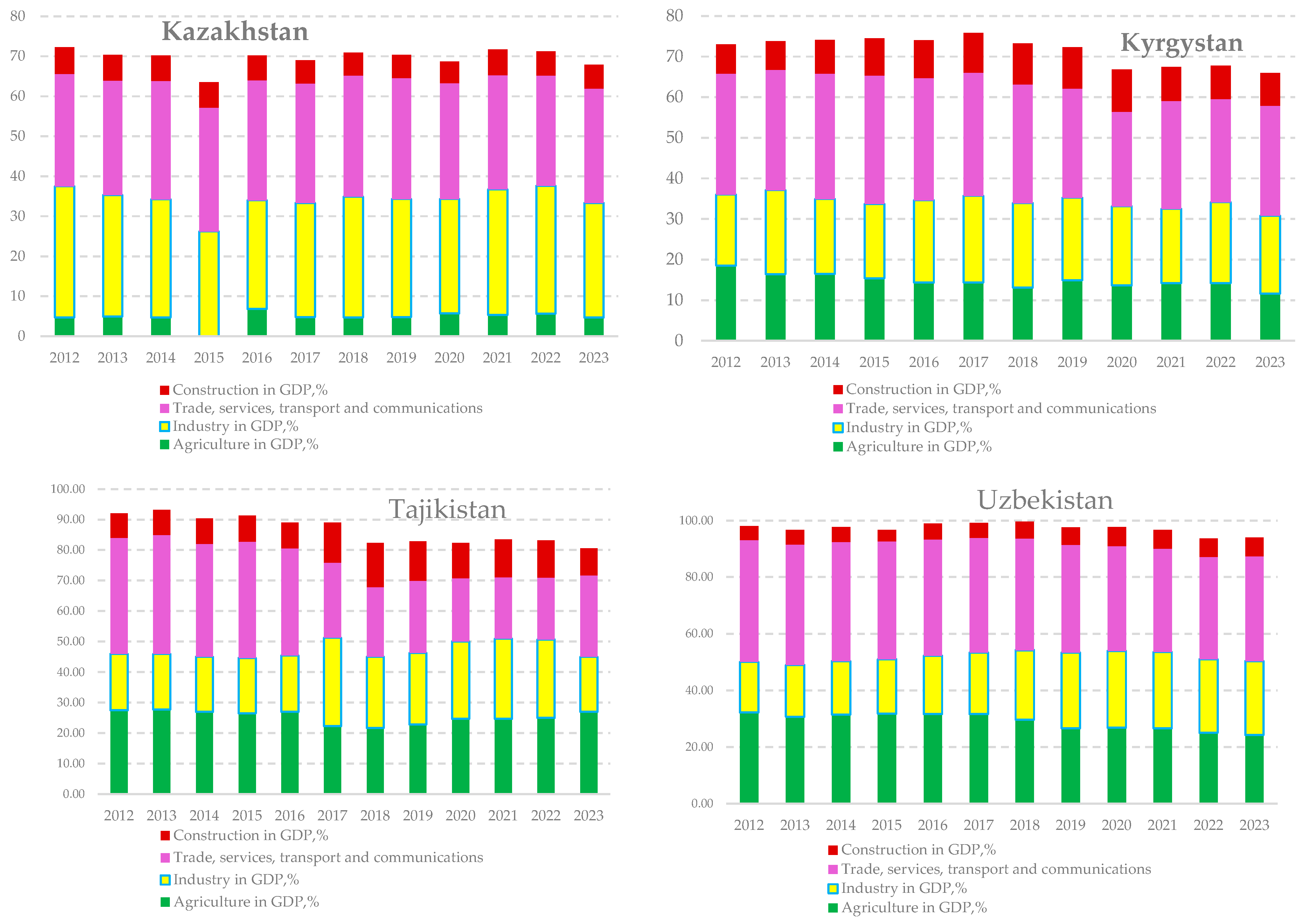
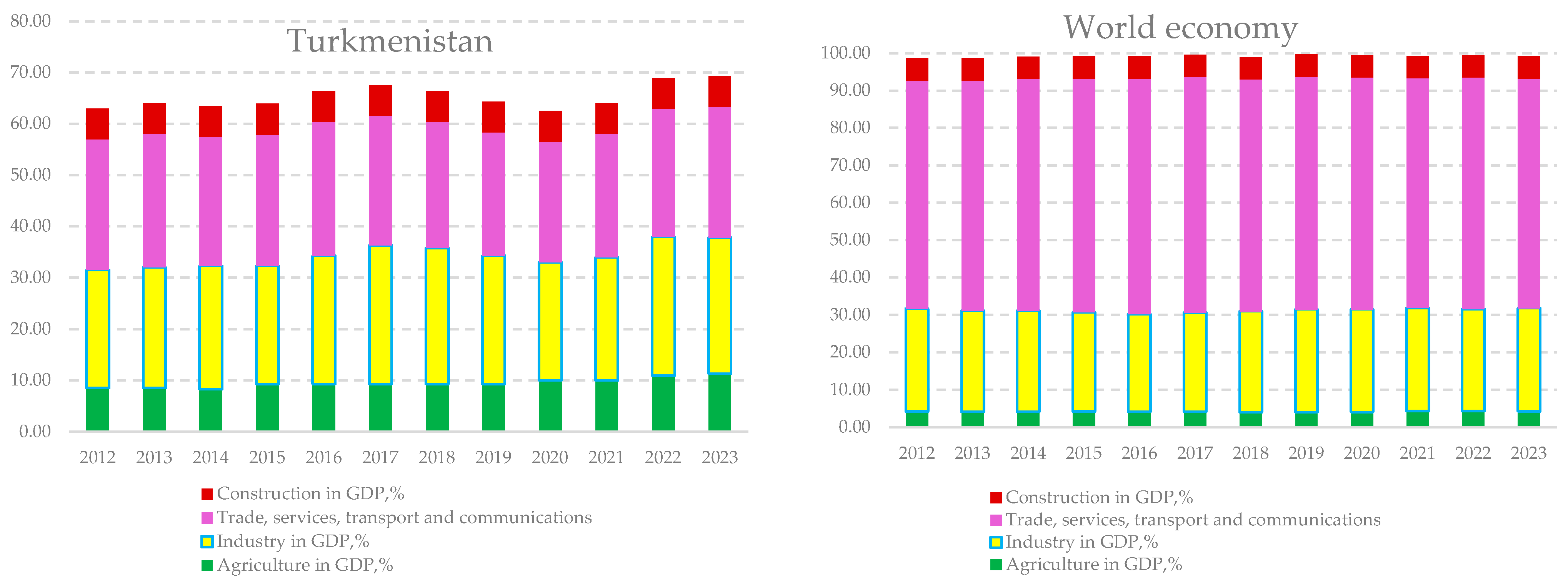

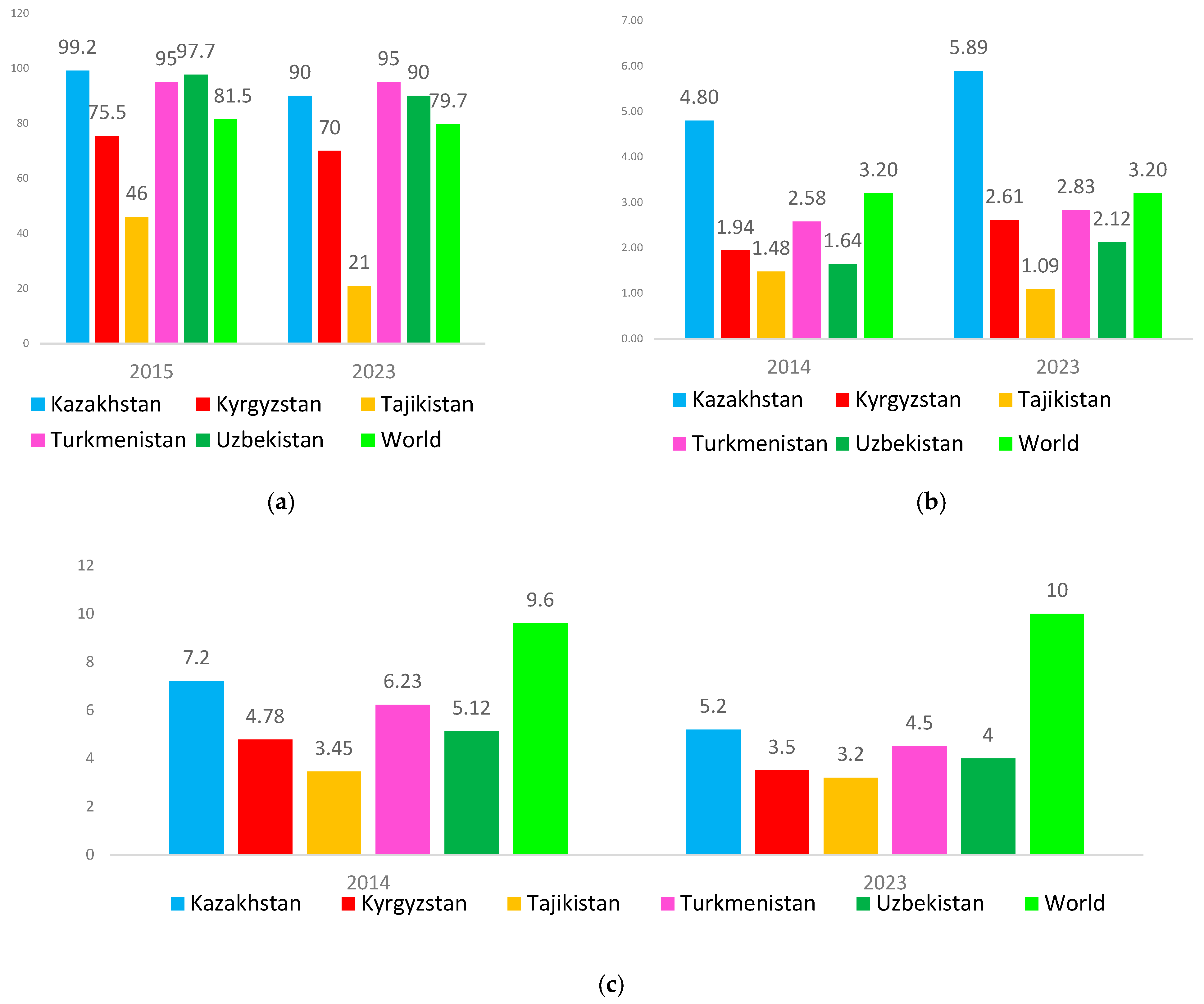
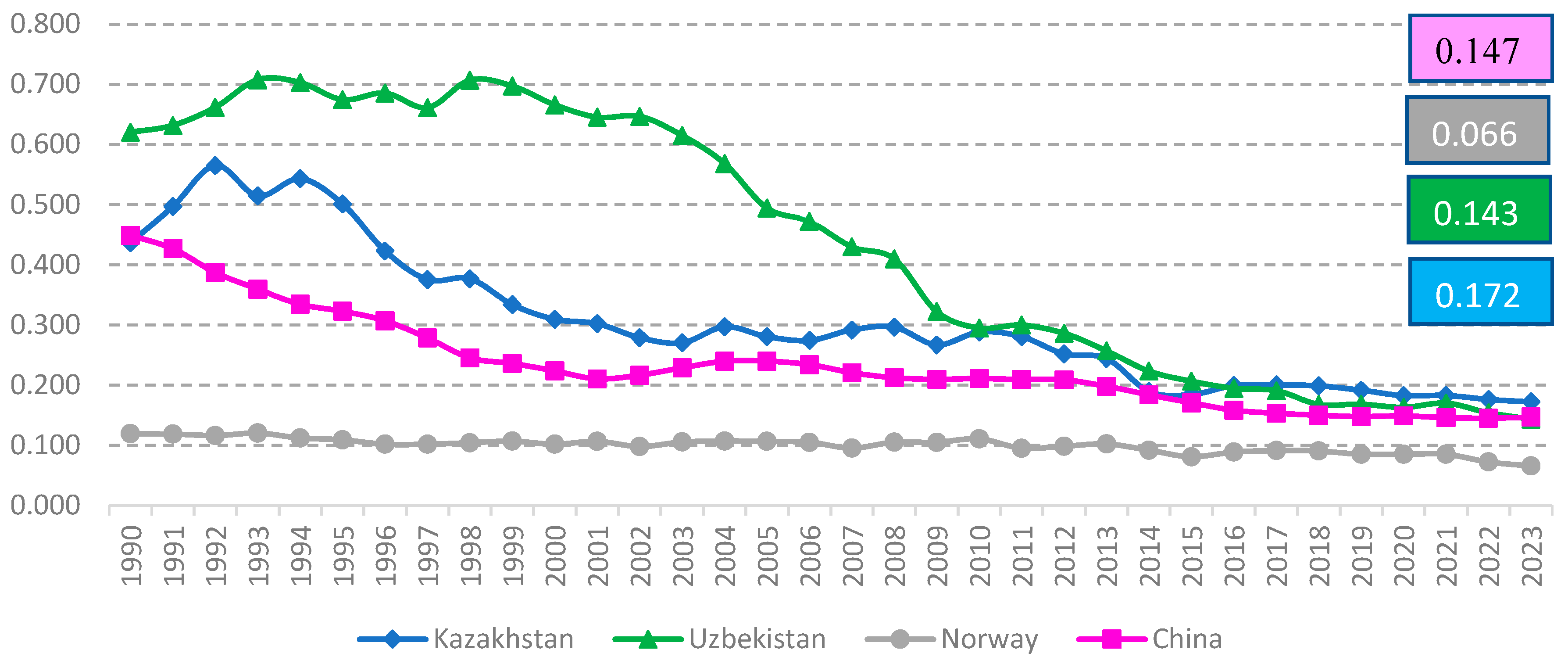
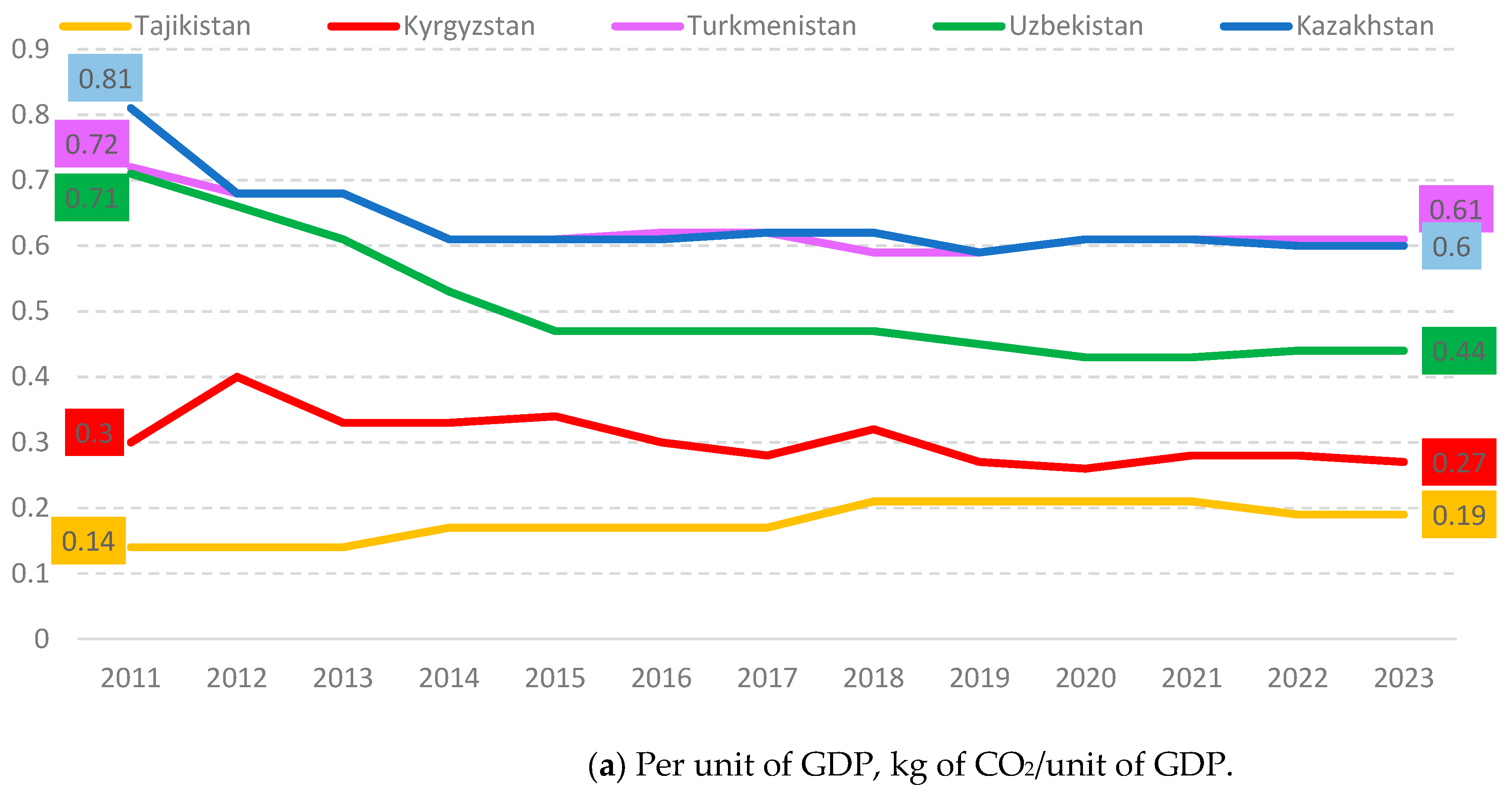

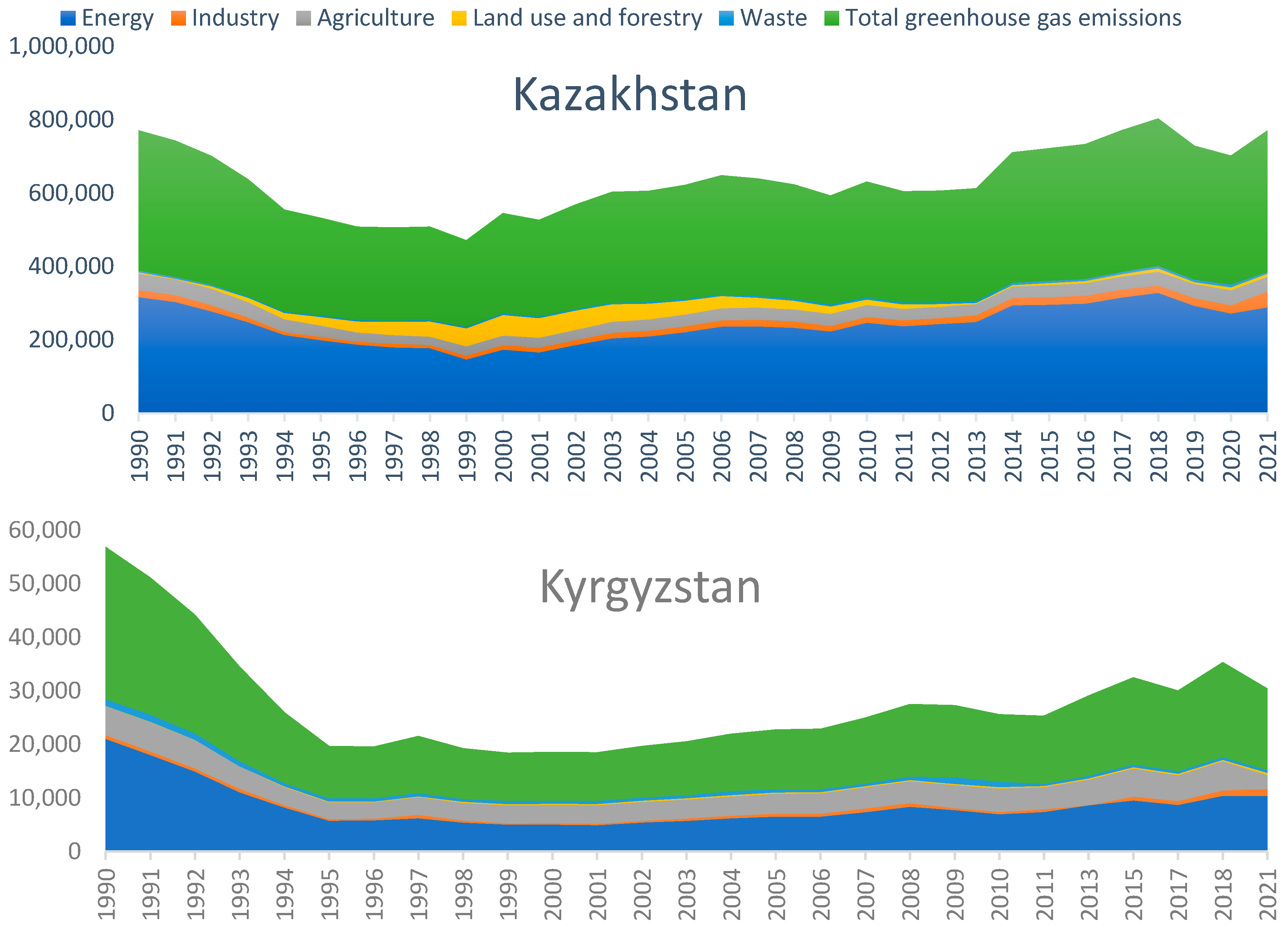
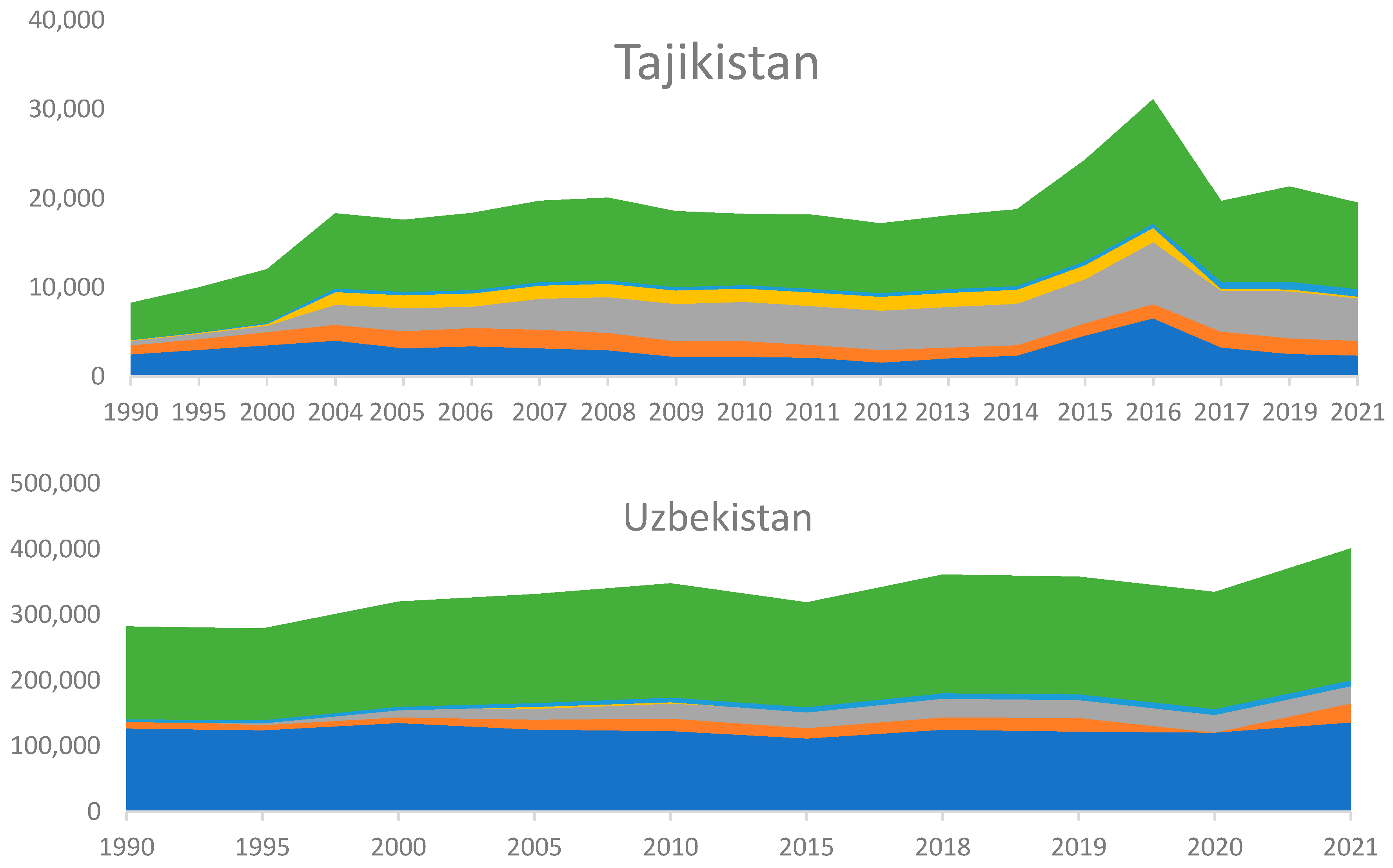
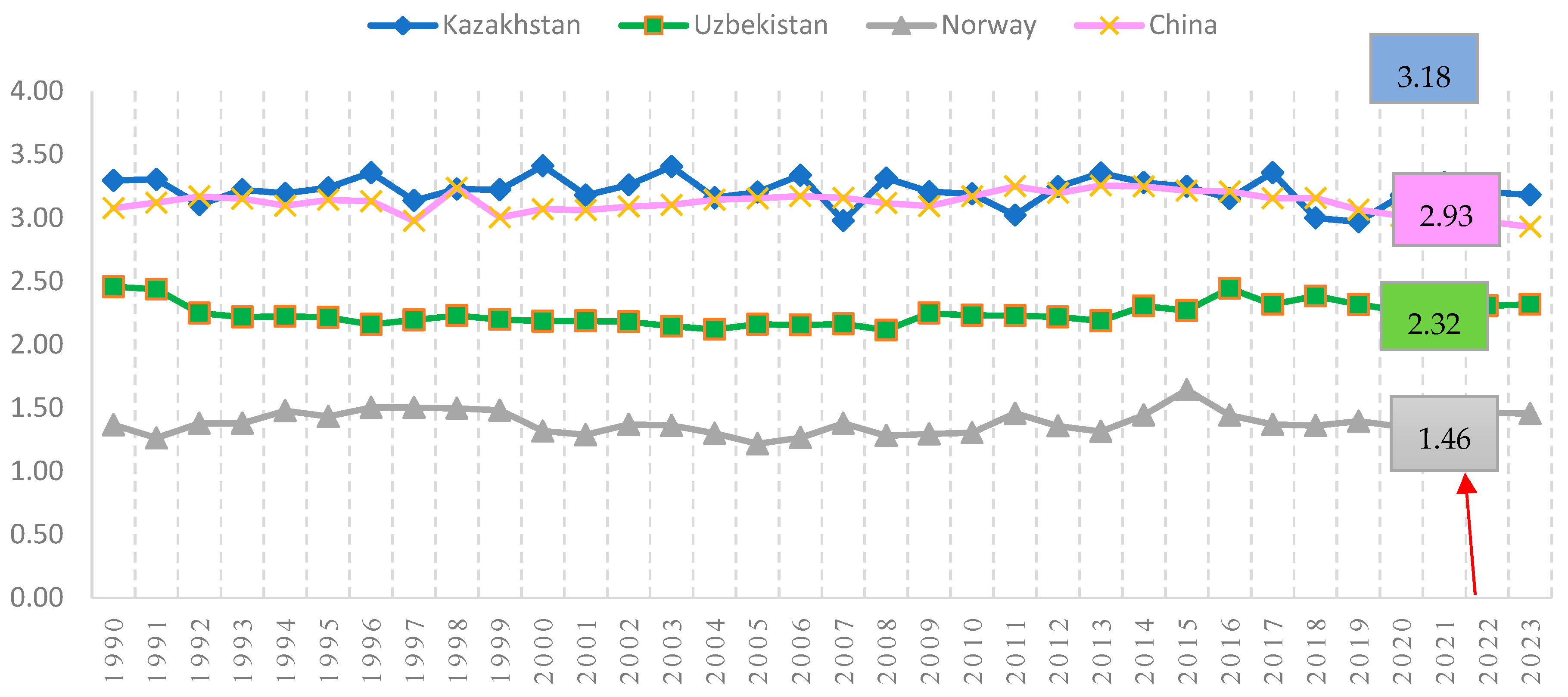
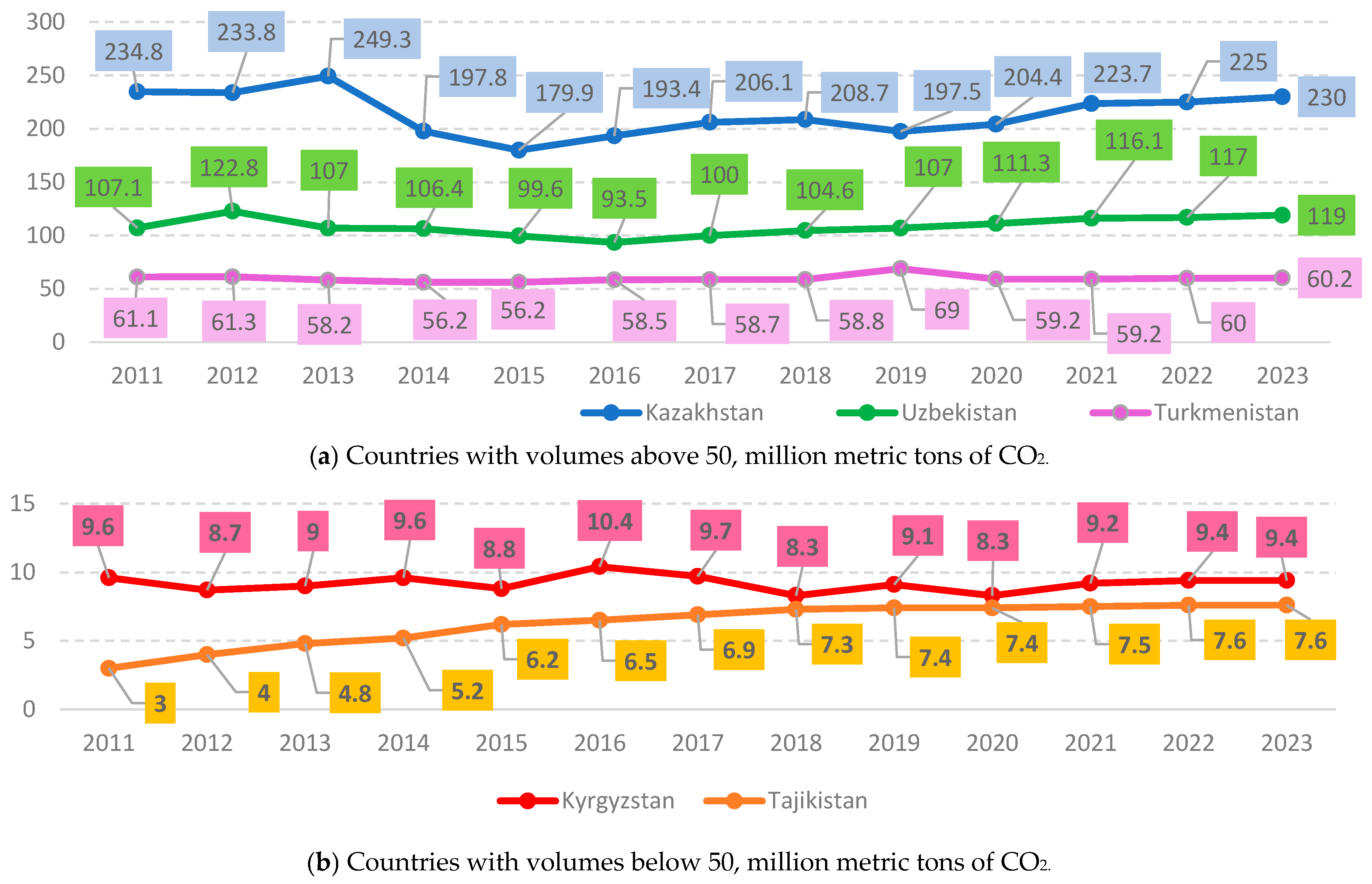

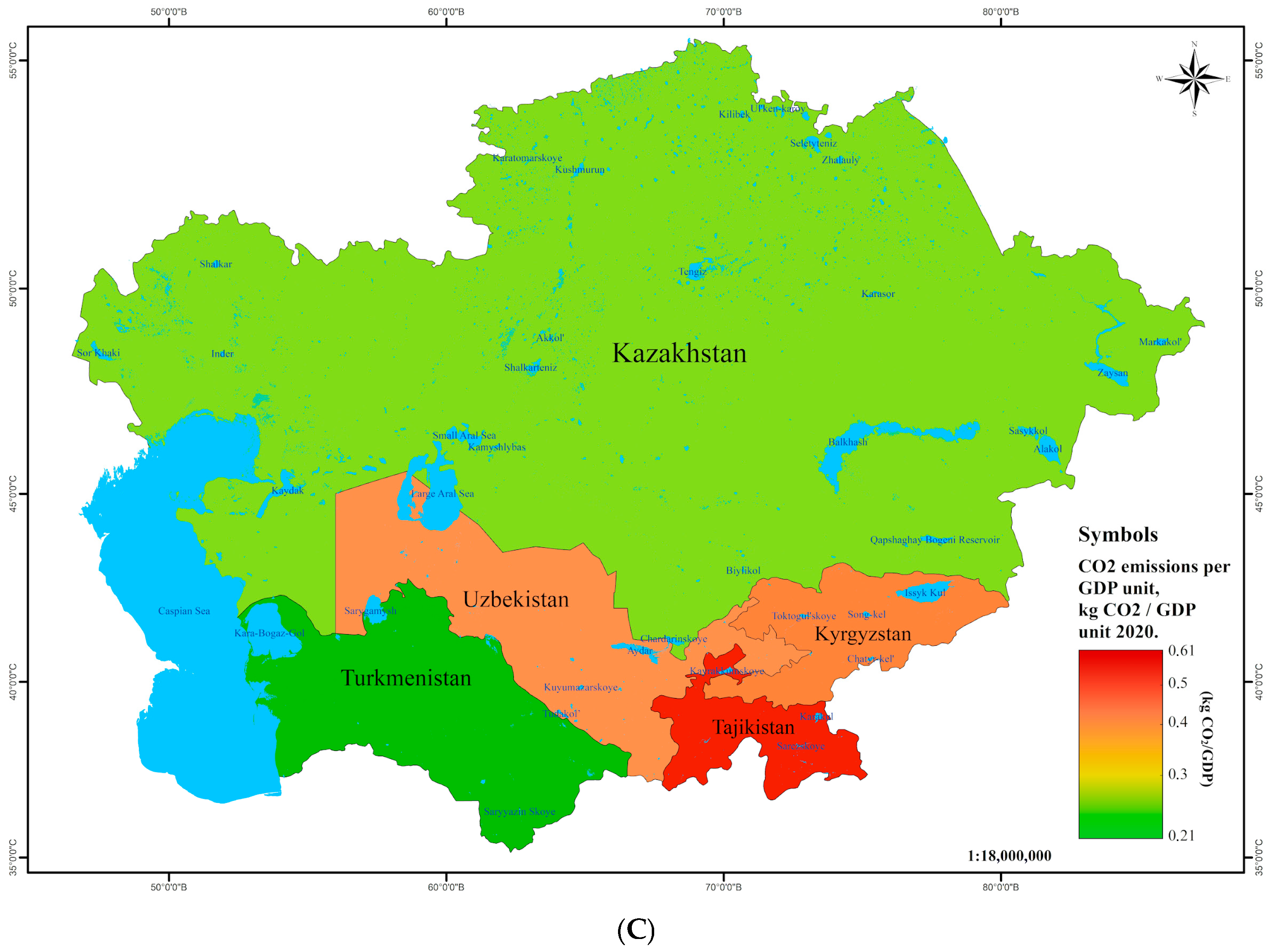
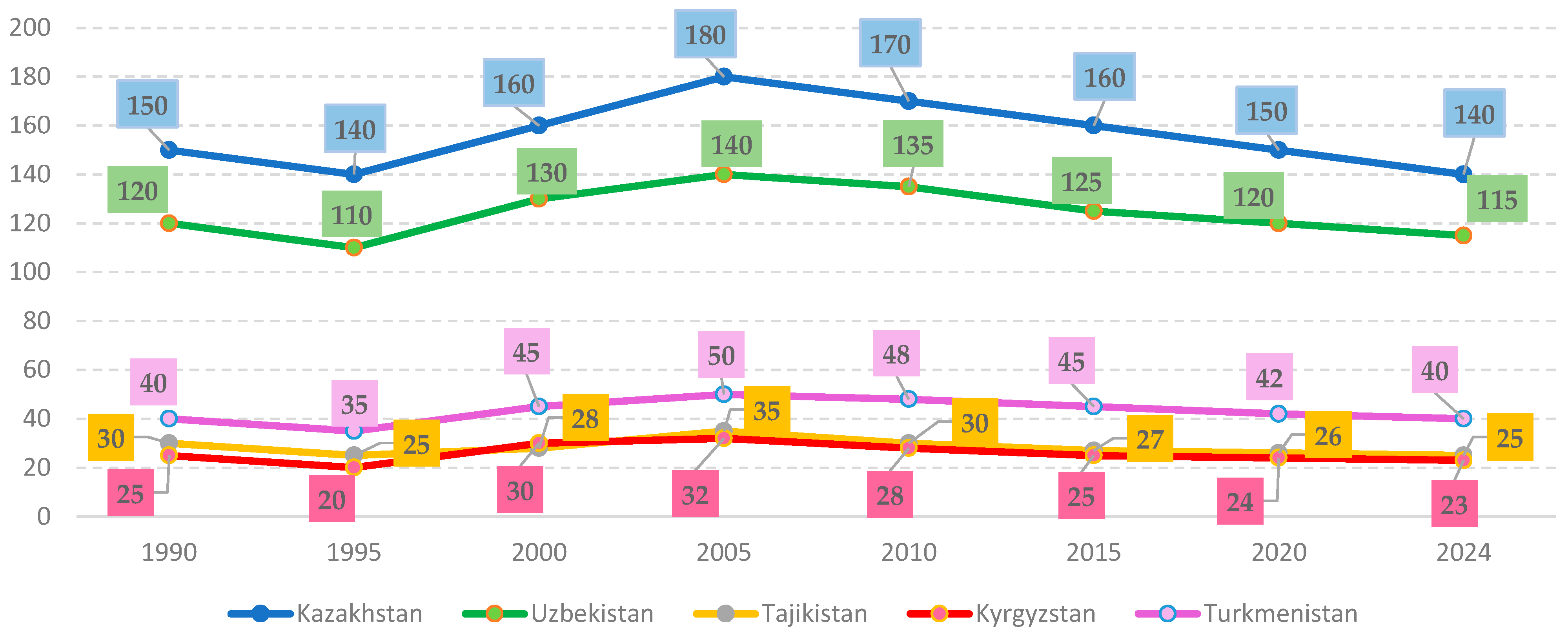


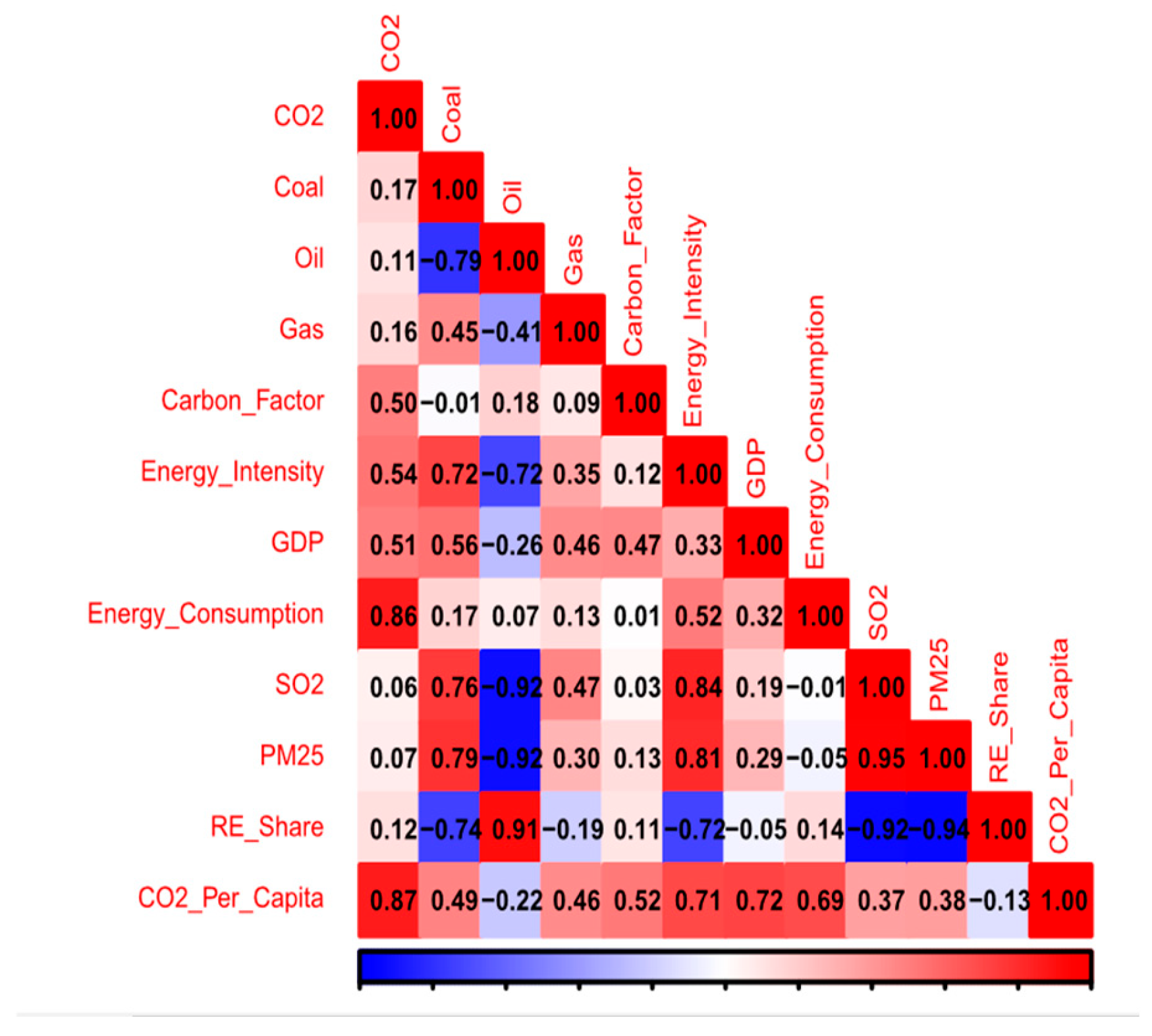
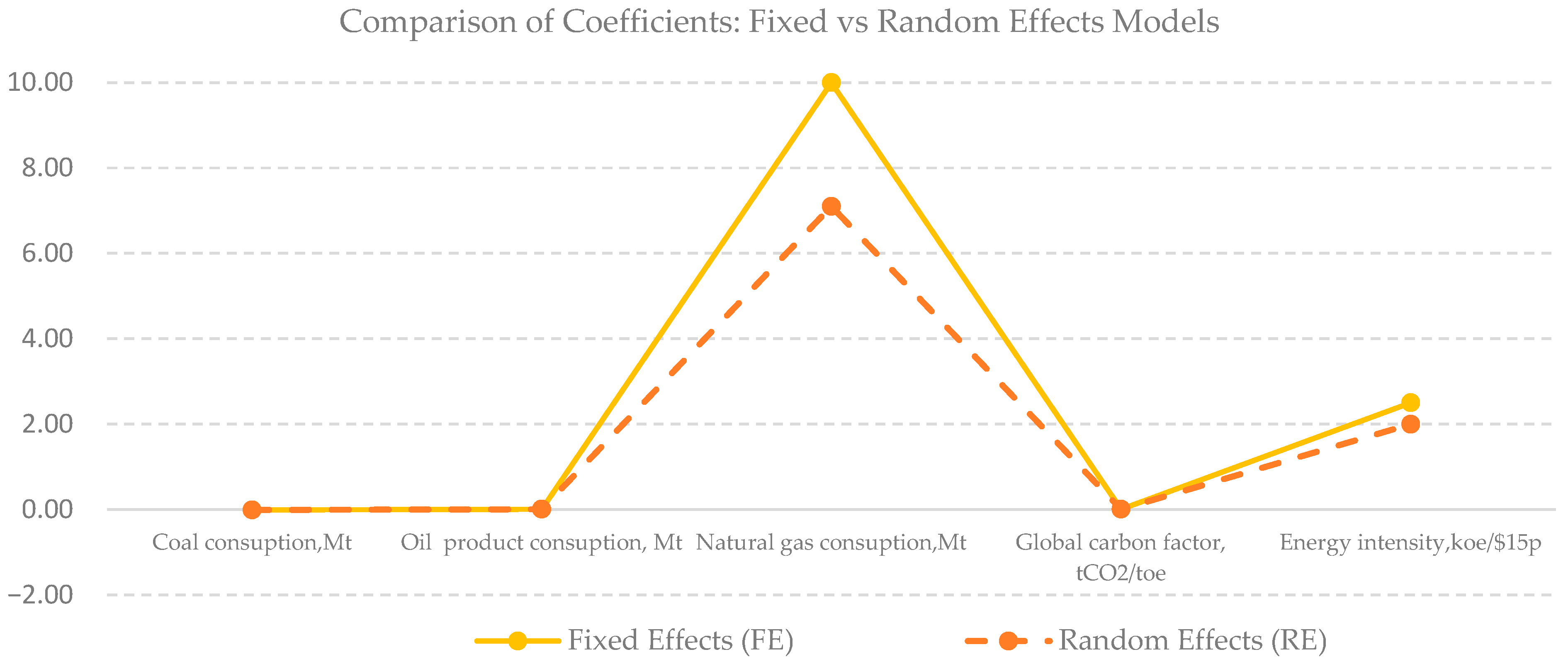
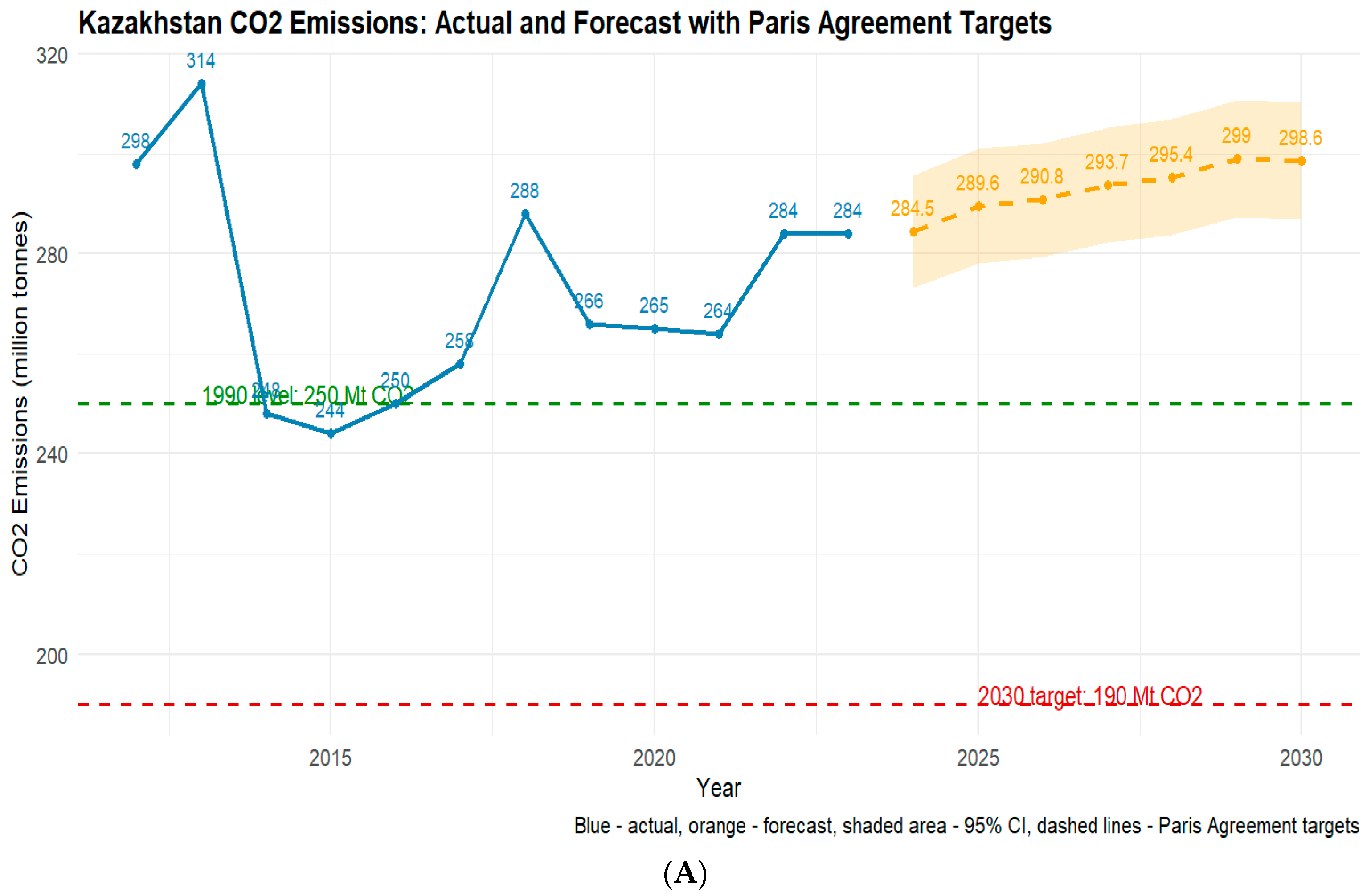
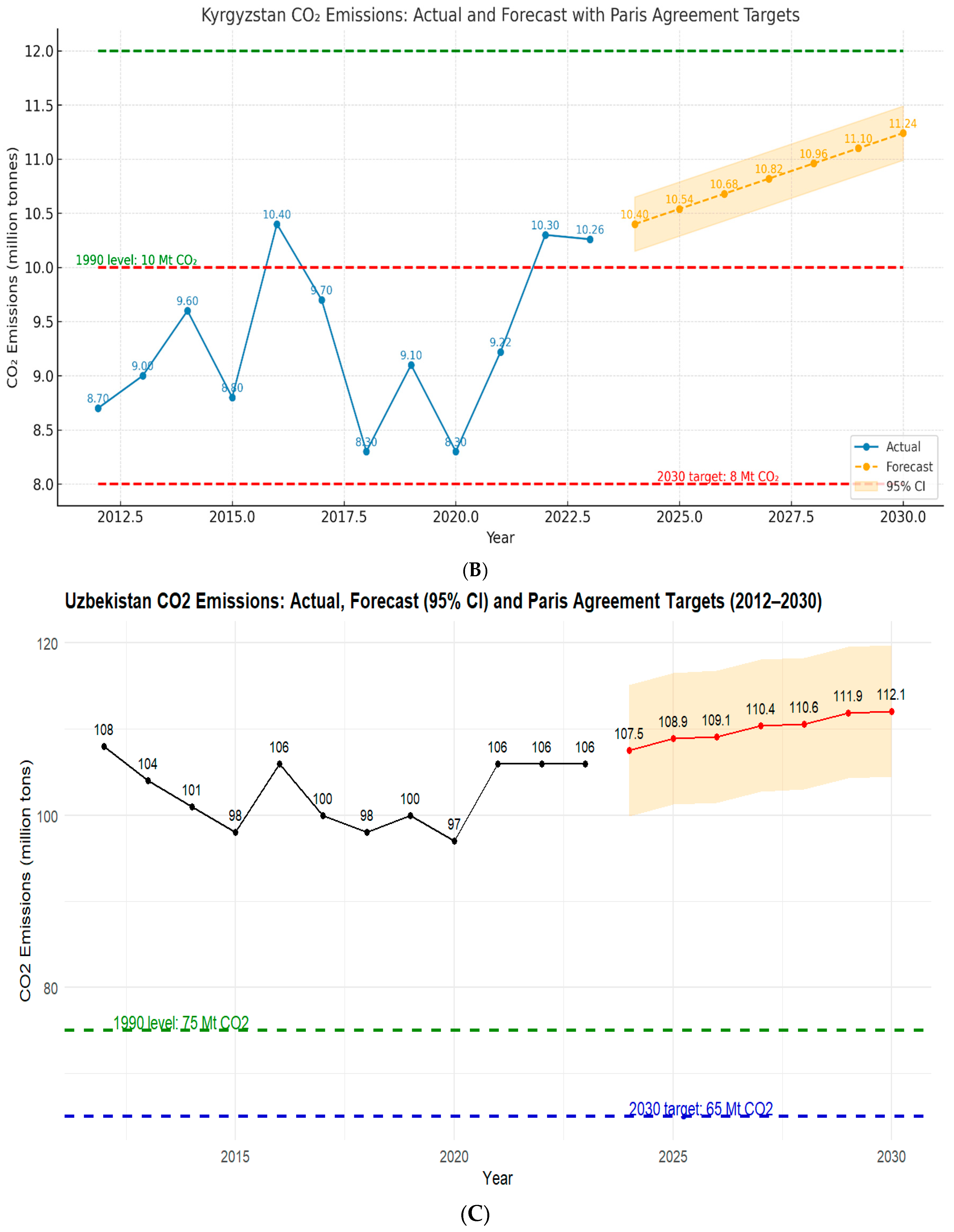
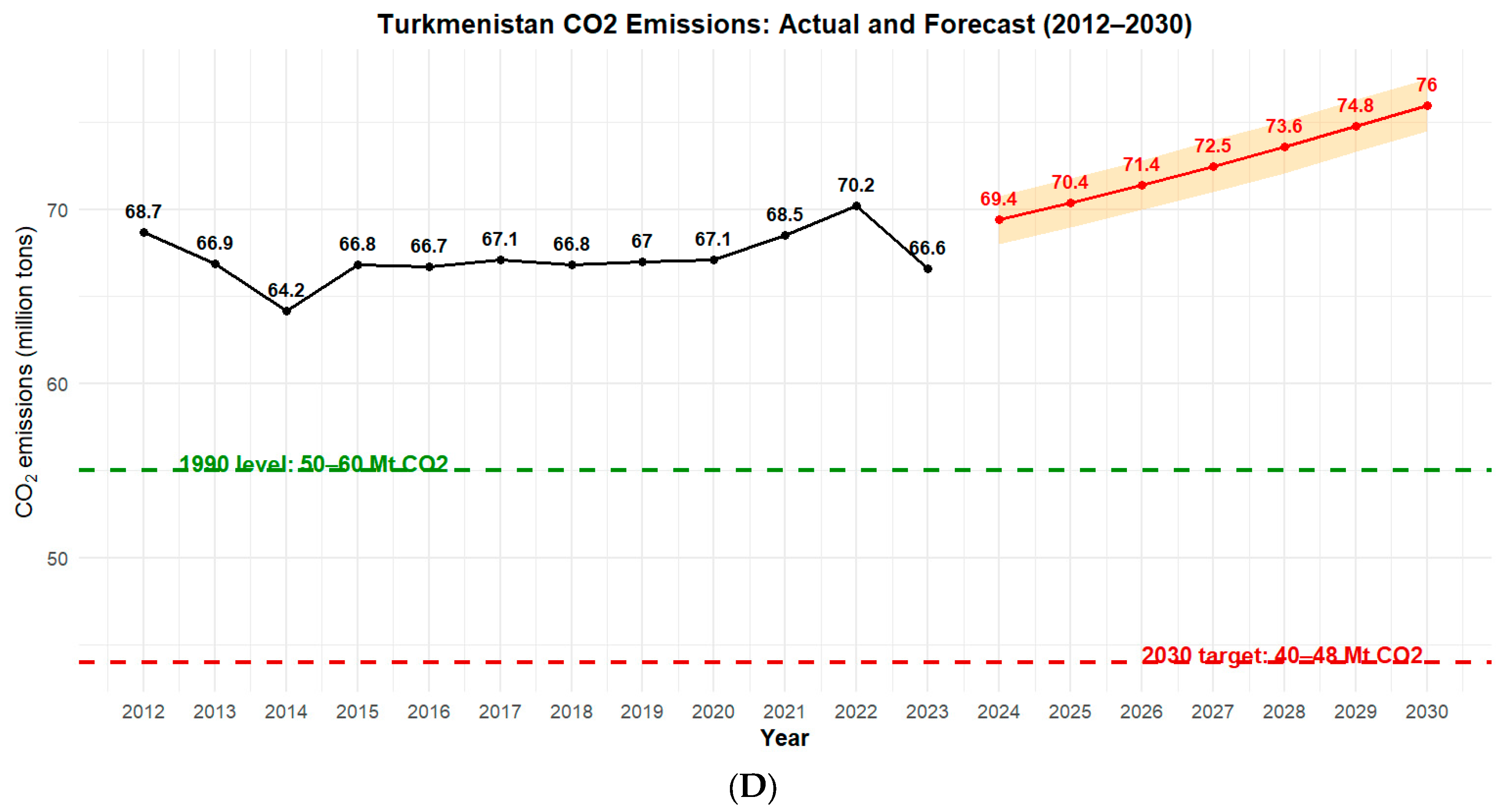
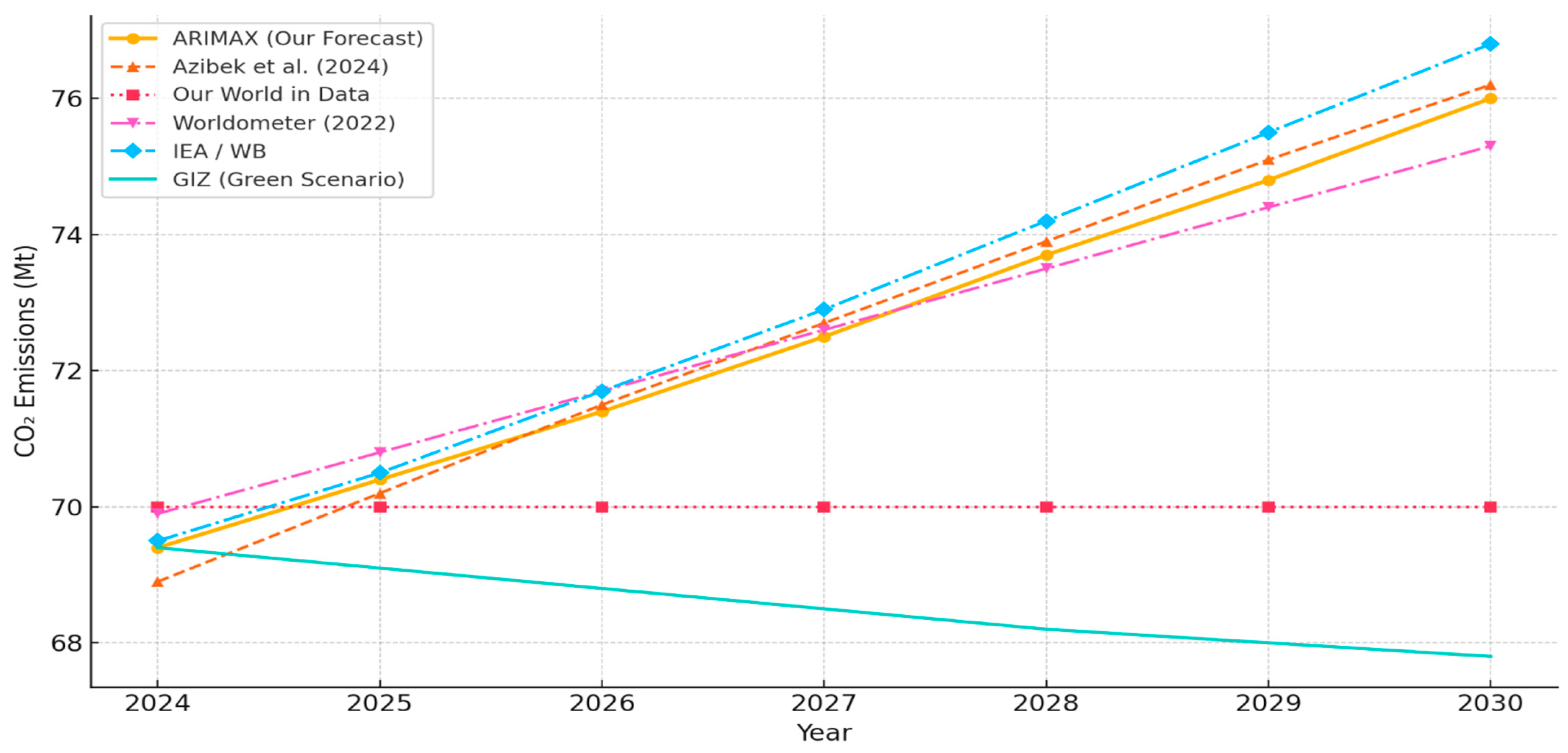
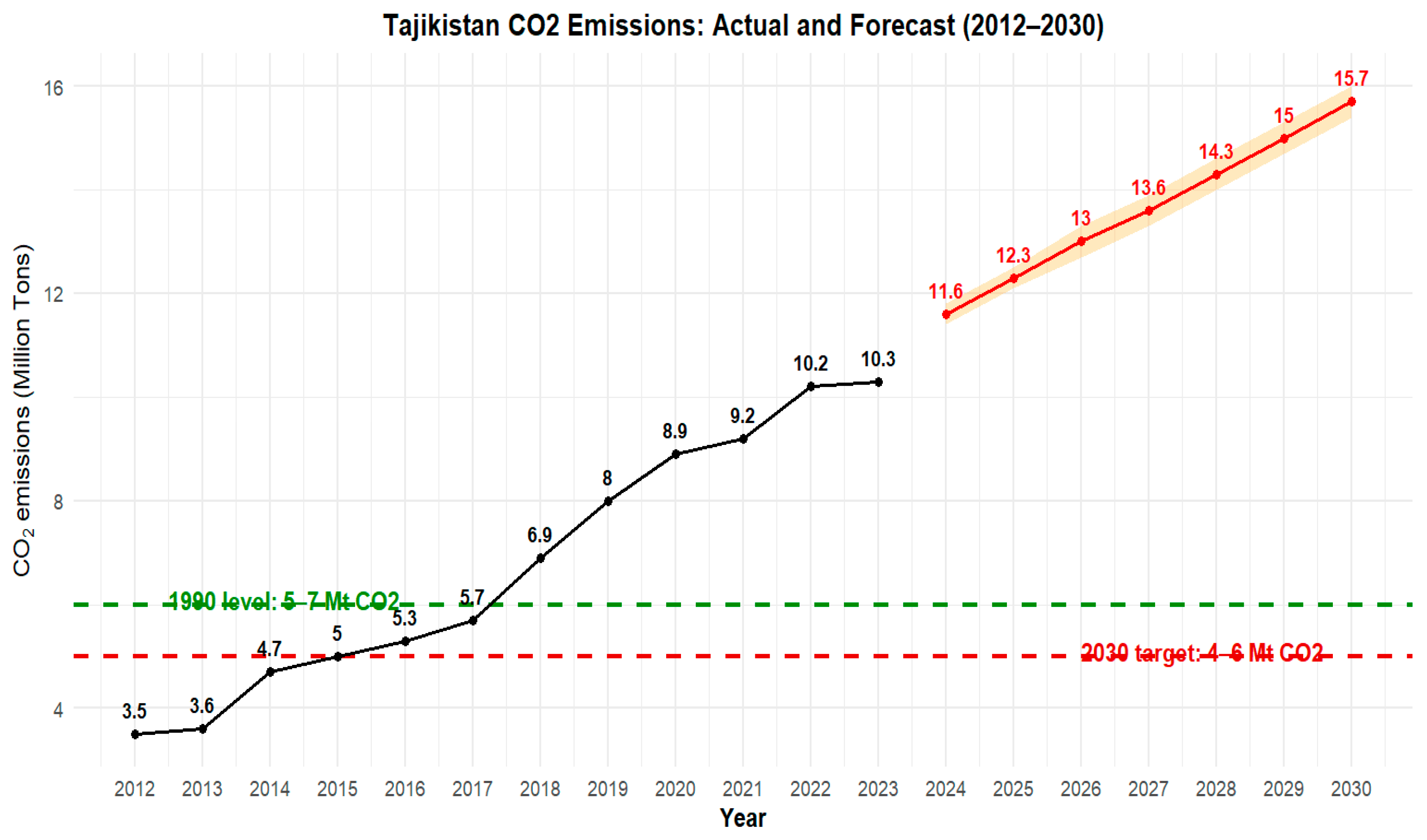

| Type of Model | Indicator | Model Equation | Data |
|---|---|---|---|
| Fixed effects model (FE) | model = “within” | model_ <- plm(CO2~Energy_Consumption + GDP + Coal + Gas + Carbon_Factor | panel_data between period of 2012–2023г across 5 countries, 60 historical values |
| Random effects model (RE) | model = “random” |
| Variable | Coefficient (FE) | Std. Error (FE) | p-Value (FE) | Coefficient (RE) | Std. Error (RE) | p-Value (RE) |
|---|---|---|---|---|---|---|
| x1 | 0.222 | 0.231 | 0.343 | 0.306 | 0.196 | 0.118 |
| x2 | −0.309 | 0.278 | 0.271 | −0.322 | 0.252 | 0.202 |
| x3 | 9.926 | 3.108 | 0.002 | 11.016 | 2.957 | 0.00019 |
| x4 | 0.121 | 0.045 | 0.009 | 0.124 | 0.045 | 0.005 |
| x5 | 2.492 | 0.249 | 0.0 | 2.560 | 0.213 | 0.0 |
| Variable | Evaluation of the Coefficient | Standard Error (FE) | t-Value | p-Value | Significance |
|---|---|---|---|---|---|
| x3- Carbon_Factor | 9.8701 | 3.0907 | 3.1935 | 0.002388 | ** |
| x4- GDP | 0.1133 | 0.0414 | 2.7369 | 0.008468 | ** |
| x5-Energy_Consumption | 2.4903 | 0.2456 | 10.1394 | 6.43 × 10−14 | *** |
| Indicator | 2024 | 2025 | 2026 | 2027 | 2028 | 2029 | 2030 | Kazakhstan (2023) |
|---|---|---|---|---|---|---|---|---|
| Energy_Consumption | 1.50% | 1.20% | 1.00% | 0.80% | 0.70% | 0.50% | 0.30% | 88.0 |
| GDP | 3.00% | 3.20% | 3.50% | 3.30% | 3.10% | 3.00% | 2.80% | 262.4 |
| Coal Consumption | −1.00% | −1.50% | −2.00% | −2.50% | −3.00% | −3.50% | −4.00% | 74.0 |
| Carbon_Factor | −0.50% | −1.00% | −1.20% | −1.50% | −1.80% | −2.00% | −2.50% | 3.23 |
| Year | Point Forecast | Lo 80 | Hi 80 | Lo 95 | Hi 95 |
|---|---|---|---|---|---|
| 2024 | 10.40497 | 10.02444 | 10.78549 | 9.823007 | 10.98693 |
| 2025 | 10.54485 | 10.16433 | 10.92538 | 9.962891 | 11.12681 |
| 2026 | 10.68474 | 10.30421 | 11.06526 | 10.102774 | 11.2667 |
| 2027 | 10.82462 | 10.44409 | 11.20514 | 10.242657 | 11.40658 |
| 2028 | 10.9645 | 10.58398 | 11.34503 | 10.382541 | 11.54646 |
| 2029 | 11.10439 | 10.72386 | 11.48491 | 10.522424 | 11.68635 |
| 2030 | 11.24427 | 10.86374 | 11.62479 | 10.662307 | 11.82623 |
| Year | CO2 Forecast | Lo 95 | Hi 95 |
|---|---|---|---|
| 2024 | 107.48 | 102.66 | 112.3 |
| 2025 | 108.89 | 104.07 | 113.71 |
| 2026 | 109.07 | 104.25 | 113.89 |
| 2027 | 110.39 | 105.57 | 115.21 |
| 2028 | 110.57 | 105.75 | 115.39 |
| 2029 | 111.88 | 107.06 | 116.7 |
| 2030 | 112.06 | 107.24 | 116.88 |
| Year | CO2 Forecast | 80% Interval | 95% Interval |
|---|---|---|---|
| 2024 | 69.36 | [67.40; 71.33] | [66.36; 72.37] |
| 2025 | 70.38 | [68.41; 72.35] | [67.37; 73.39] |
| 2026 | 71.43 | [69.46; 73.40] | [68.42; 74.44] |
| 2027 | 72.52 | [70.55; 74.49] | [69.51; 75.53] |
| 2028 | 73.65 | [71.68; 75.61] | [70.64; 76.65] |
| 2029 | 74.81 | [72.85; 76.78] | [71.80; 77.82] |
| 2030 | 76.02 | [74.05; 77.98] | [73.01; 79.03] |
| Year | CO2 Forecast | 80% Interval | 95% Interval |
|---|---|---|---|
| 2024 | 11.58 | [10.93; 12.23] | [10.58; 12.57] |
| 2025 | 12.27 | [11.35; 13.19] | [10.86; 13.68] |
| 2026 | 12.96 | [11.83; 14.09] | [11.23; 14.68] |
| 2027 | 13.64 | [12.34; 14.95] | [11.65; 15.64] |
| 2028 | 14.32 | [12.86; 15.78] | [12.09; 16.55] |
| 2029 | 15.00 | [13.40; 16.59] | [12.56; 17.44] |
| 2030 | 15.67 | [13.95; 17.40] | [13.04; 18.31] |
Disclaimer/Publisher’s Note: The statements, opinions and data contained in all publications are solely those of the individual author(s) and contributor(s) and not of MDPI and/or the editor(s). MDPI and/or the editor(s) disclaim responsibility for any injury to people or property resulting from any ideas, methods, instructions or products referred to in the content. |
© 2025 by the authors. Licensee MDPI, Basel, Switzerland. This article is an open access article distributed under the terms and conditions of the Creative Commons Attribution (CC BY) license (https://creativecommons.org/licenses/by/4.0/).
Share and Cite
Kozhagulov, S.; Adambekova, A.; Quadrado, J.C.; Salnikov, V.; Rysmagambetova, A.; Tanybayeva, A. Trends in Atmospheric Emissions in Central Asian Countries Since 1990 in the Context of Regional Development. Climate 2025, 13, 176. https://doi.org/10.3390/cli13090176
Kozhagulov S, Adambekova A, Quadrado JC, Salnikov V, Rysmagambetova A, Tanybayeva A. Trends in Atmospheric Emissions in Central Asian Countries Since 1990 in the Context of Regional Development. Climate. 2025; 13(9):176. https://doi.org/10.3390/cli13090176
Chicago/Turabian StyleKozhagulov, Saken, Ainagul Adambekova, Jose Carlos Quadrado, Vitaliy Salnikov, Aina Rysmagambetova, and Ainur Tanybayeva. 2025. "Trends in Atmospheric Emissions in Central Asian Countries Since 1990 in the Context of Regional Development" Climate 13, no. 9: 176. https://doi.org/10.3390/cli13090176
APA StyleKozhagulov, S., Adambekova, A., Quadrado, J. C., Salnikov, V., Rysmagambetova, A., & Tanybayeva, A. (2025). Trends in Atmospheric Emissions in Central Asian Countries Since 1990 in the Context of Regional Development. Climate, 13(9), 176. https://doi.org/10.3390/cli13090176








